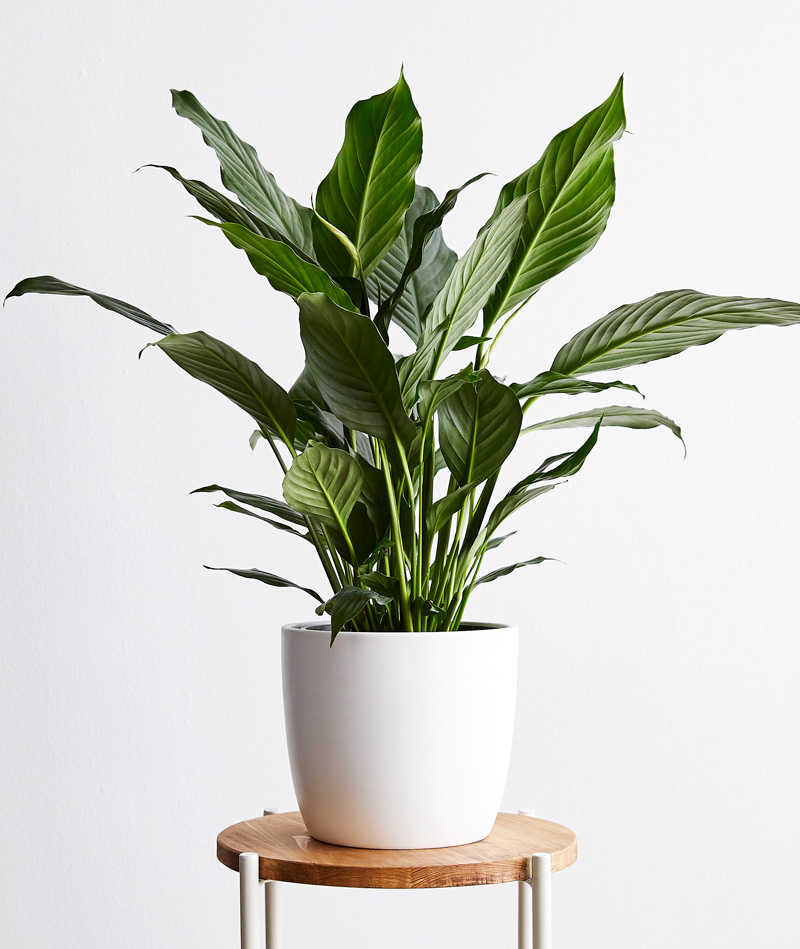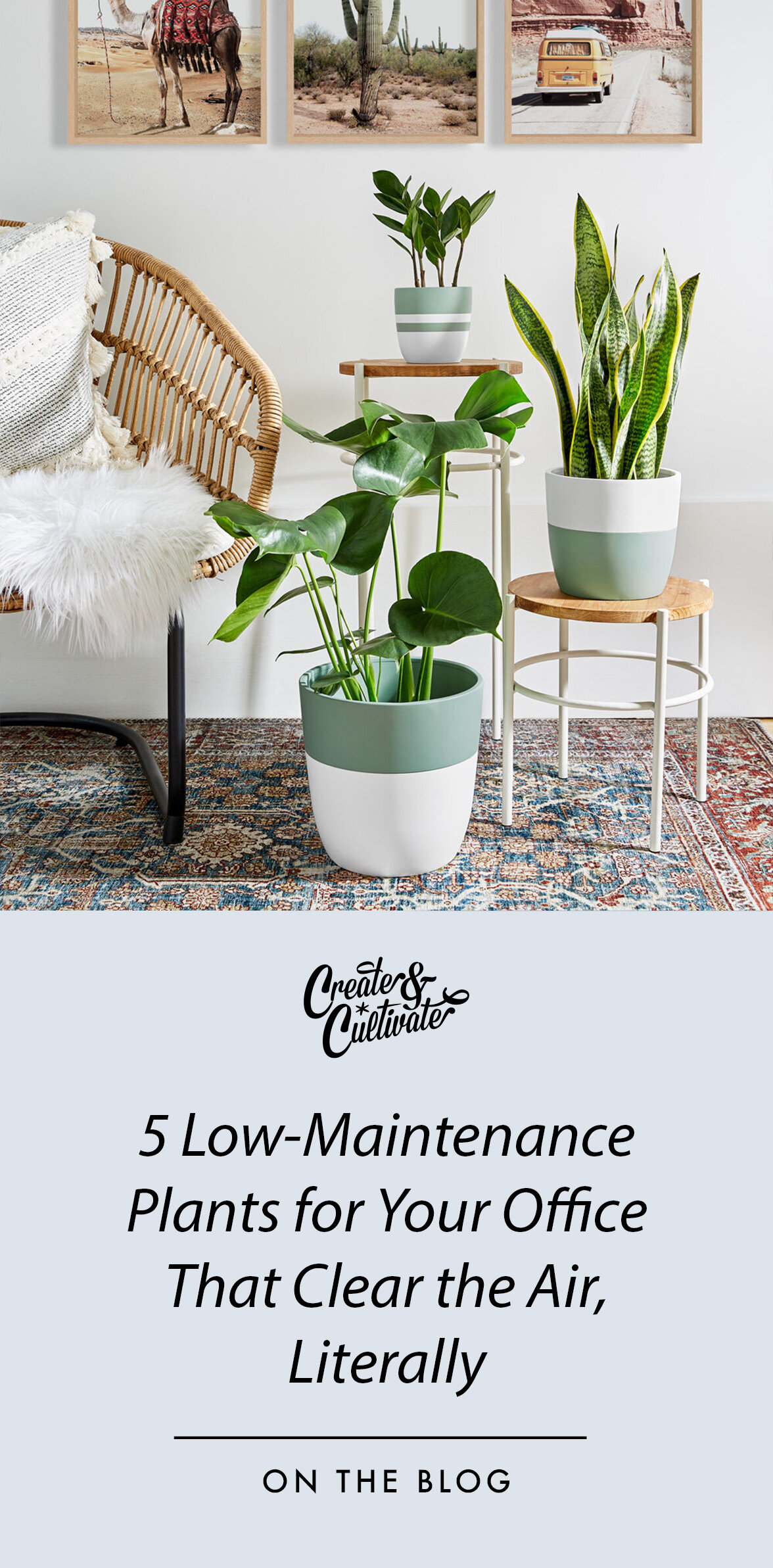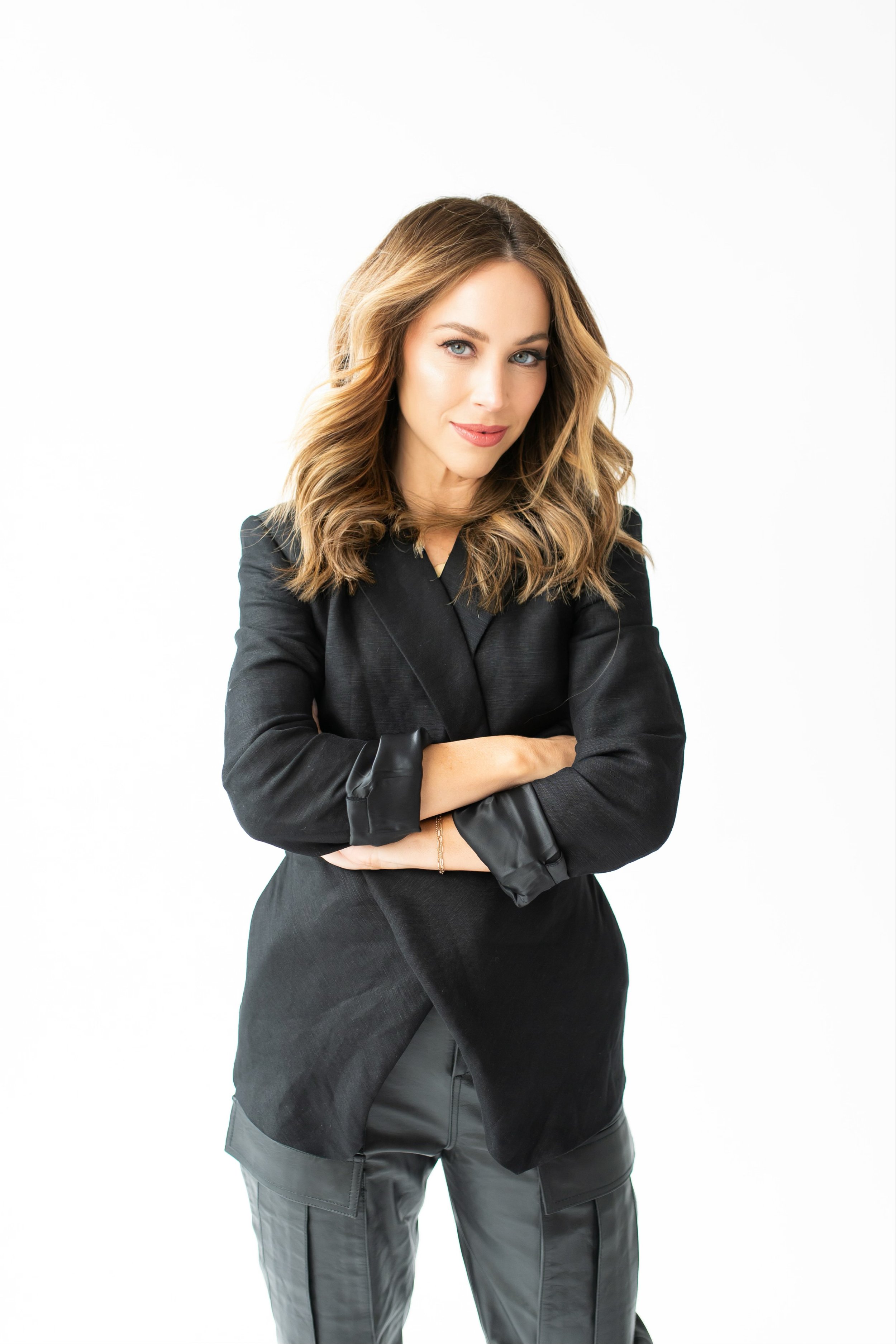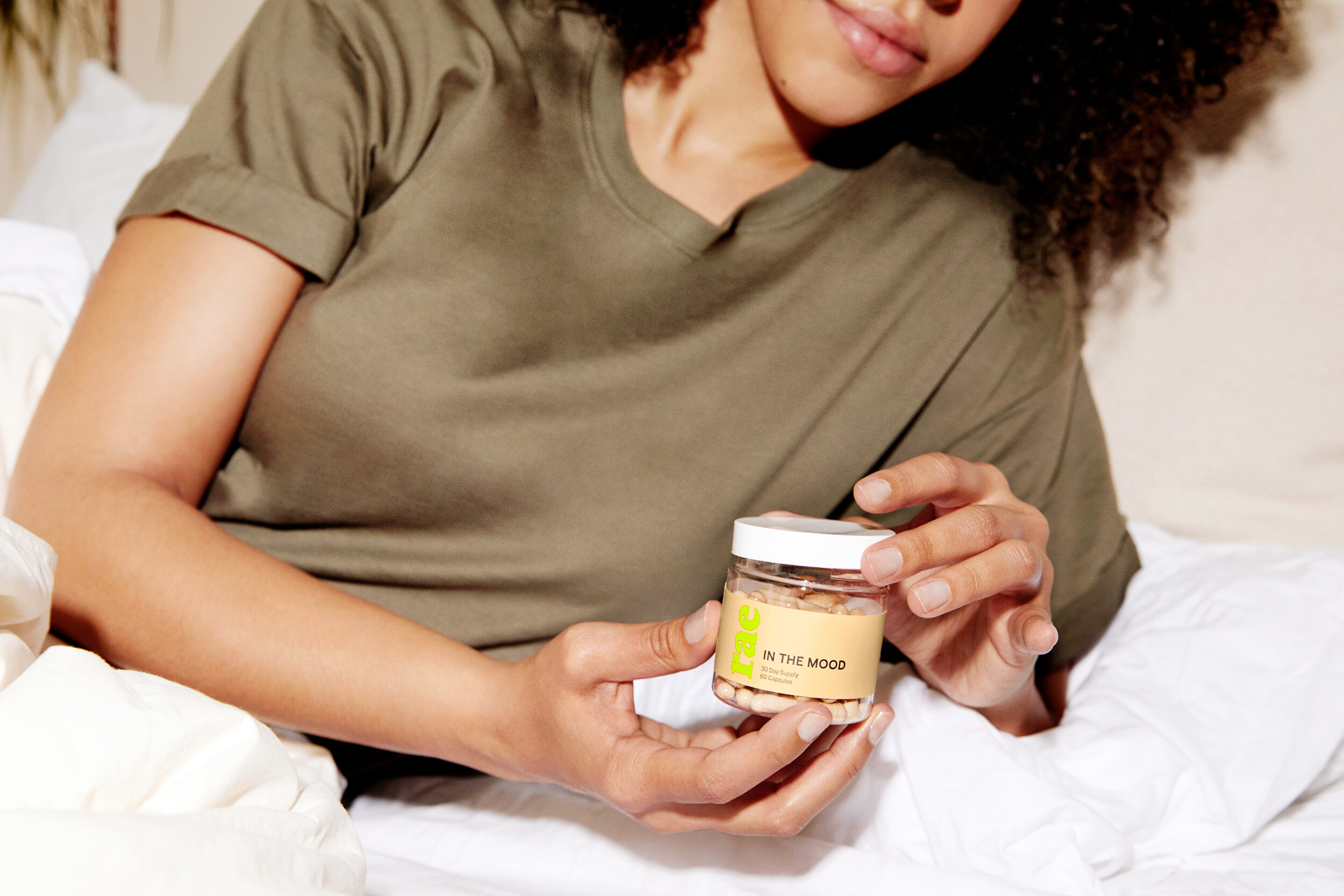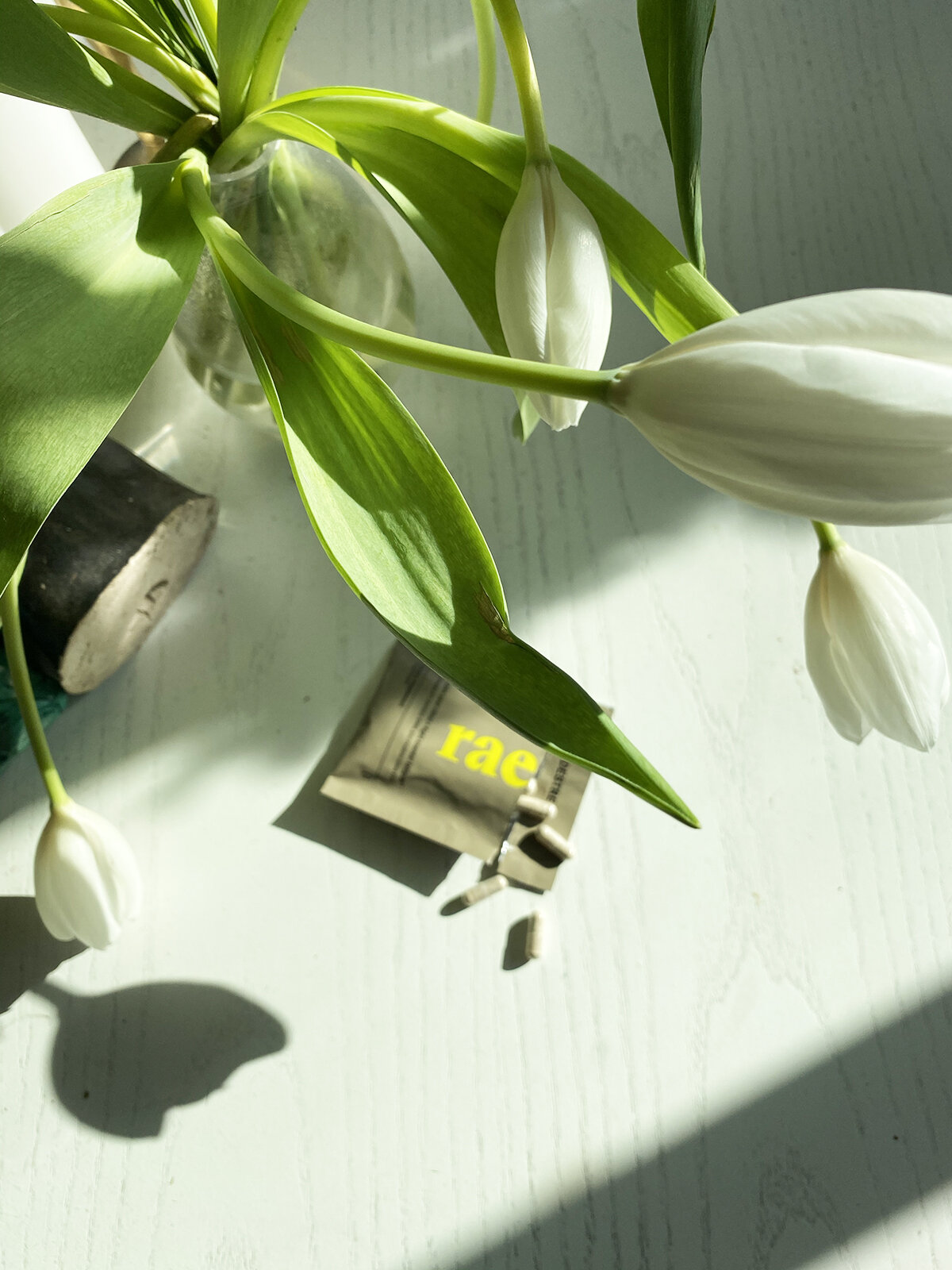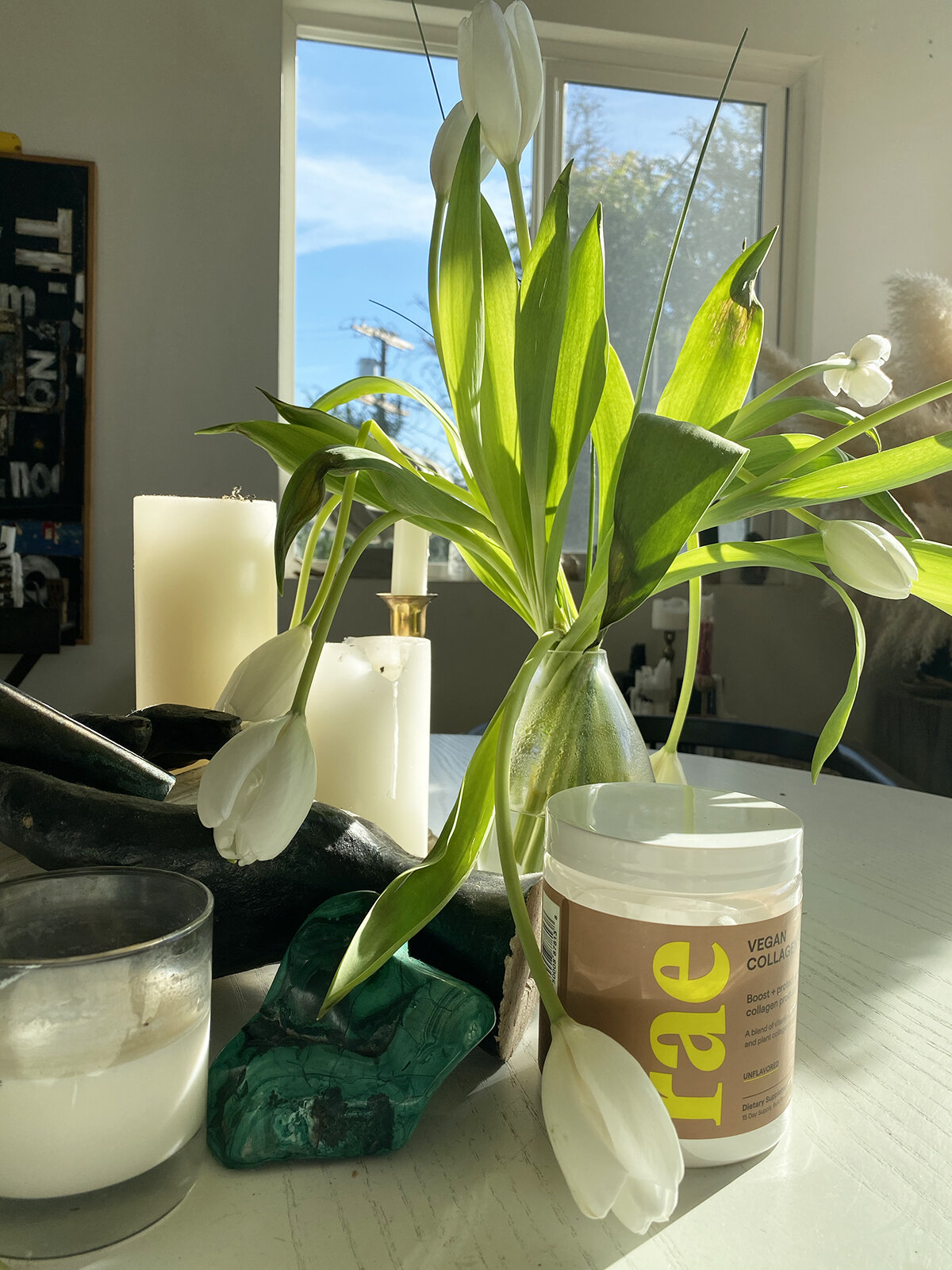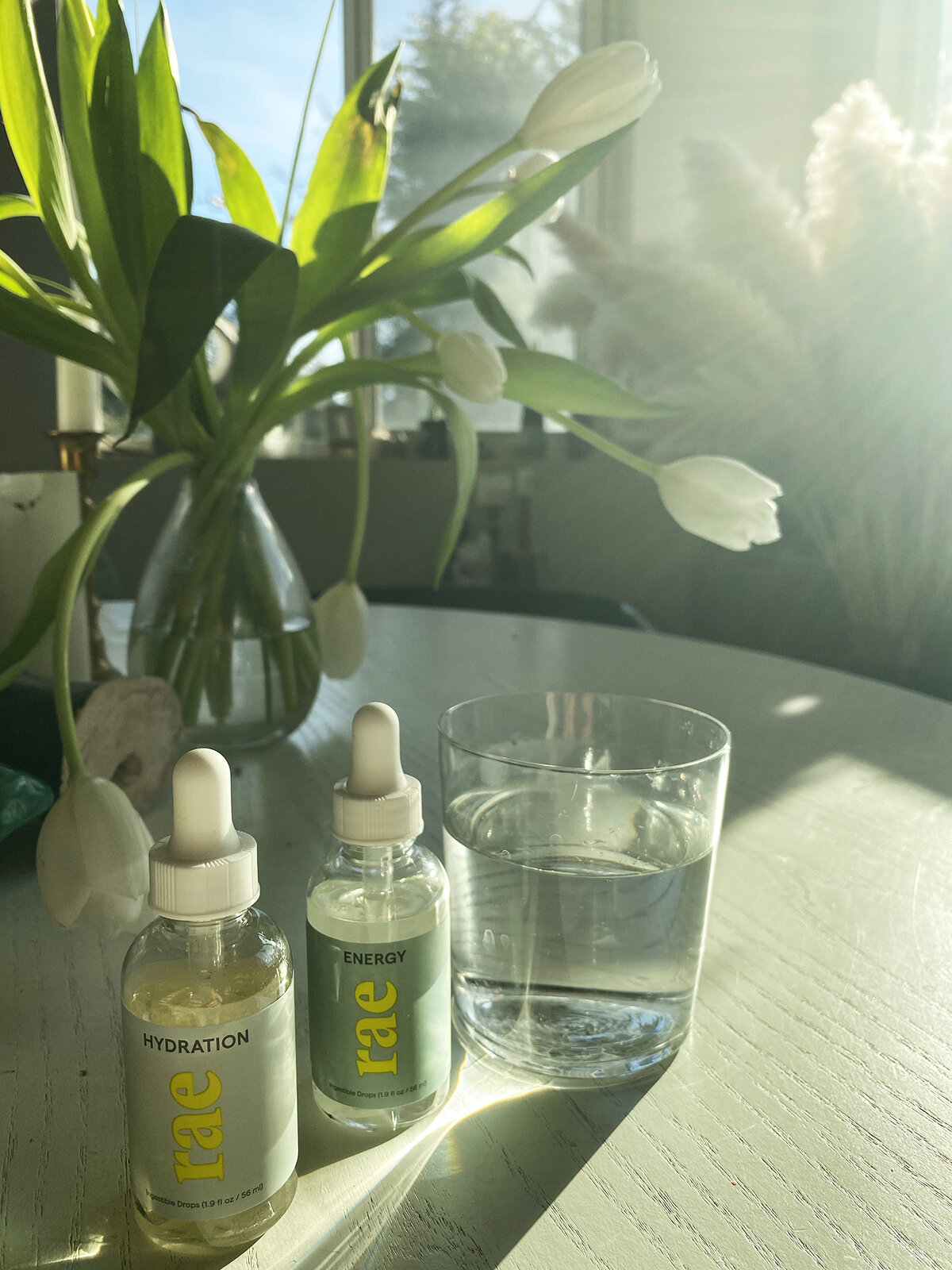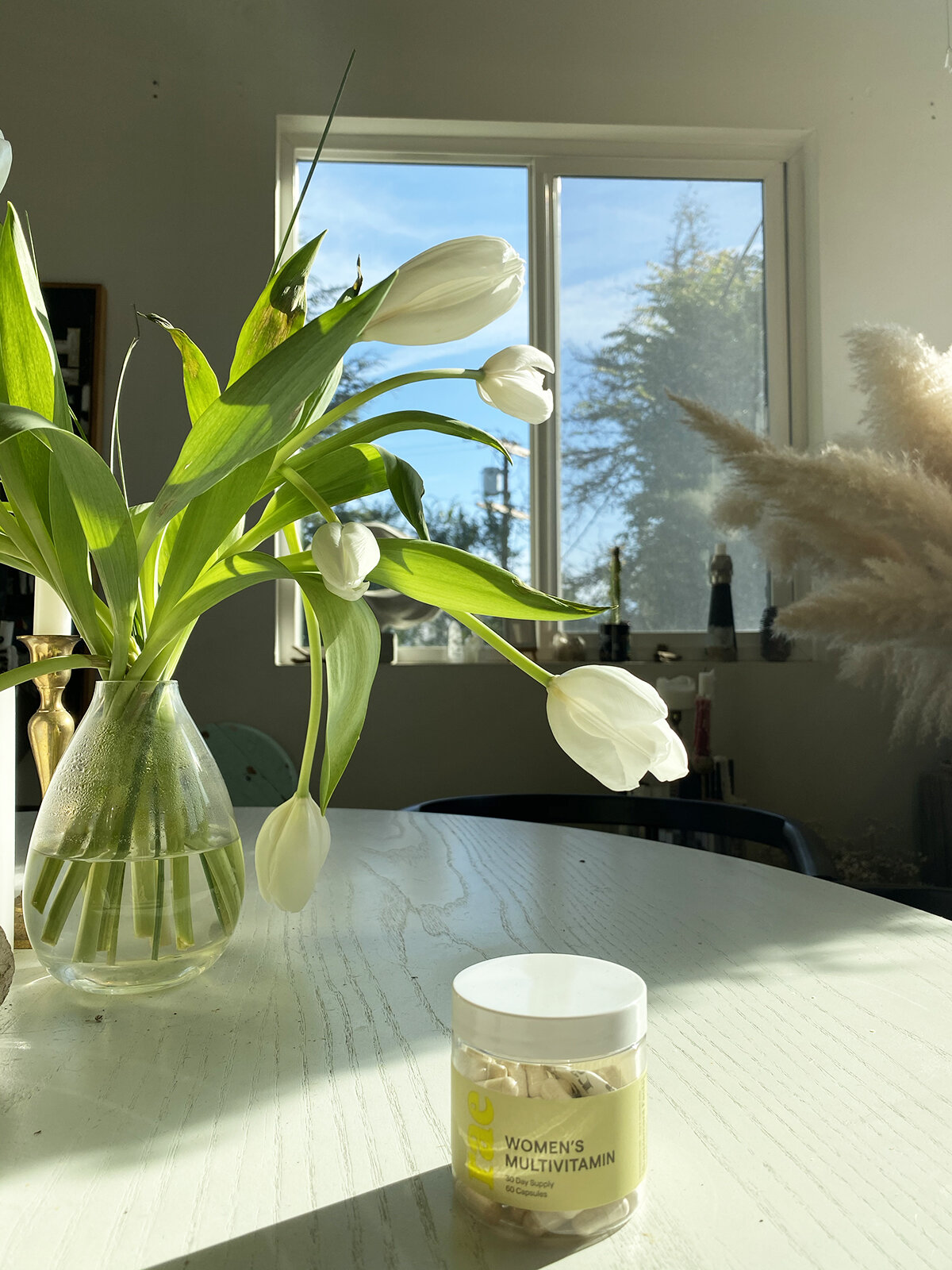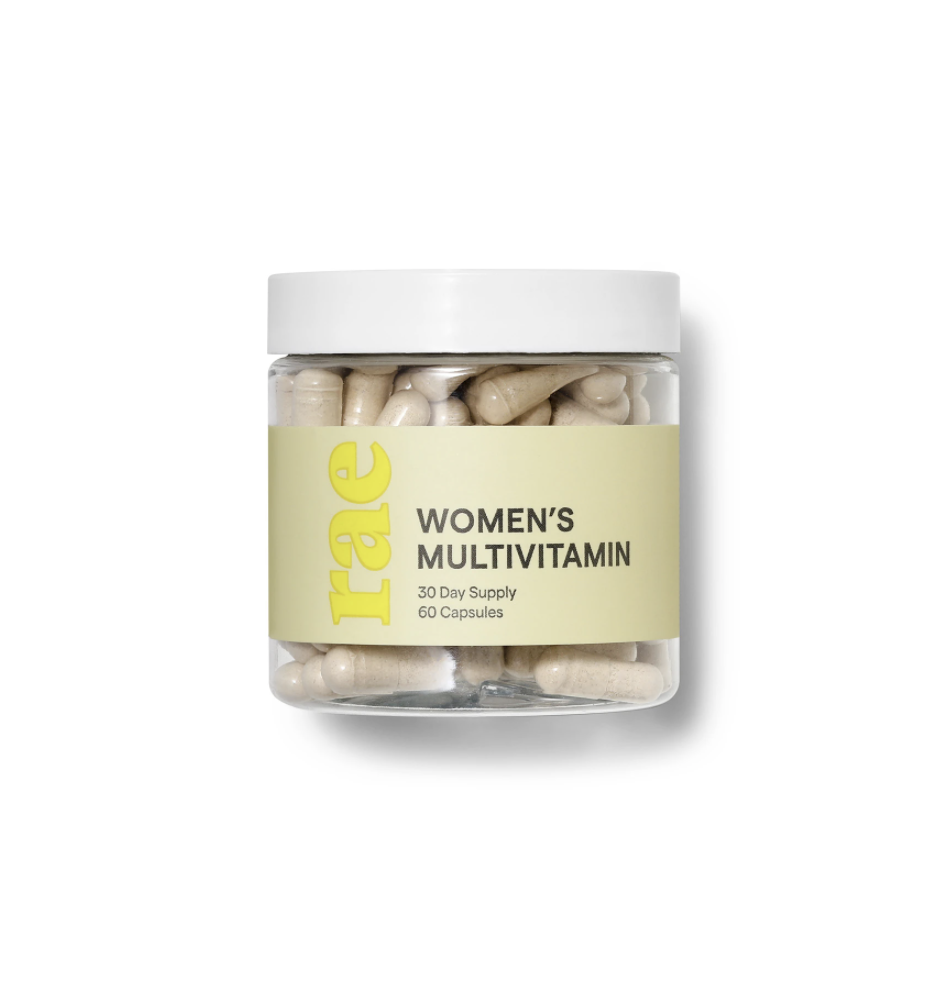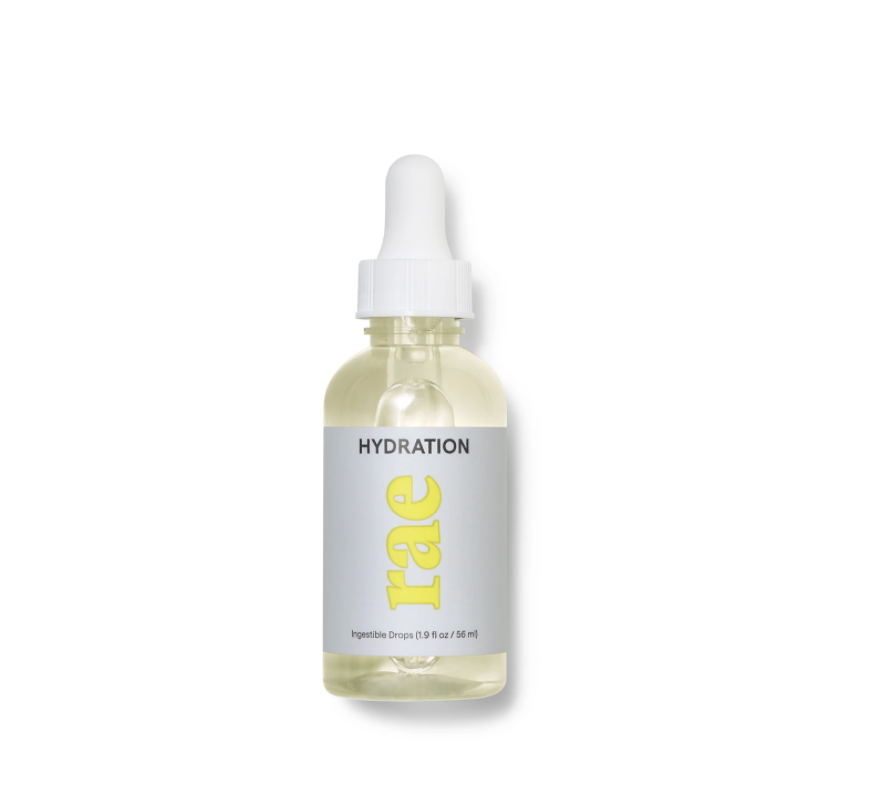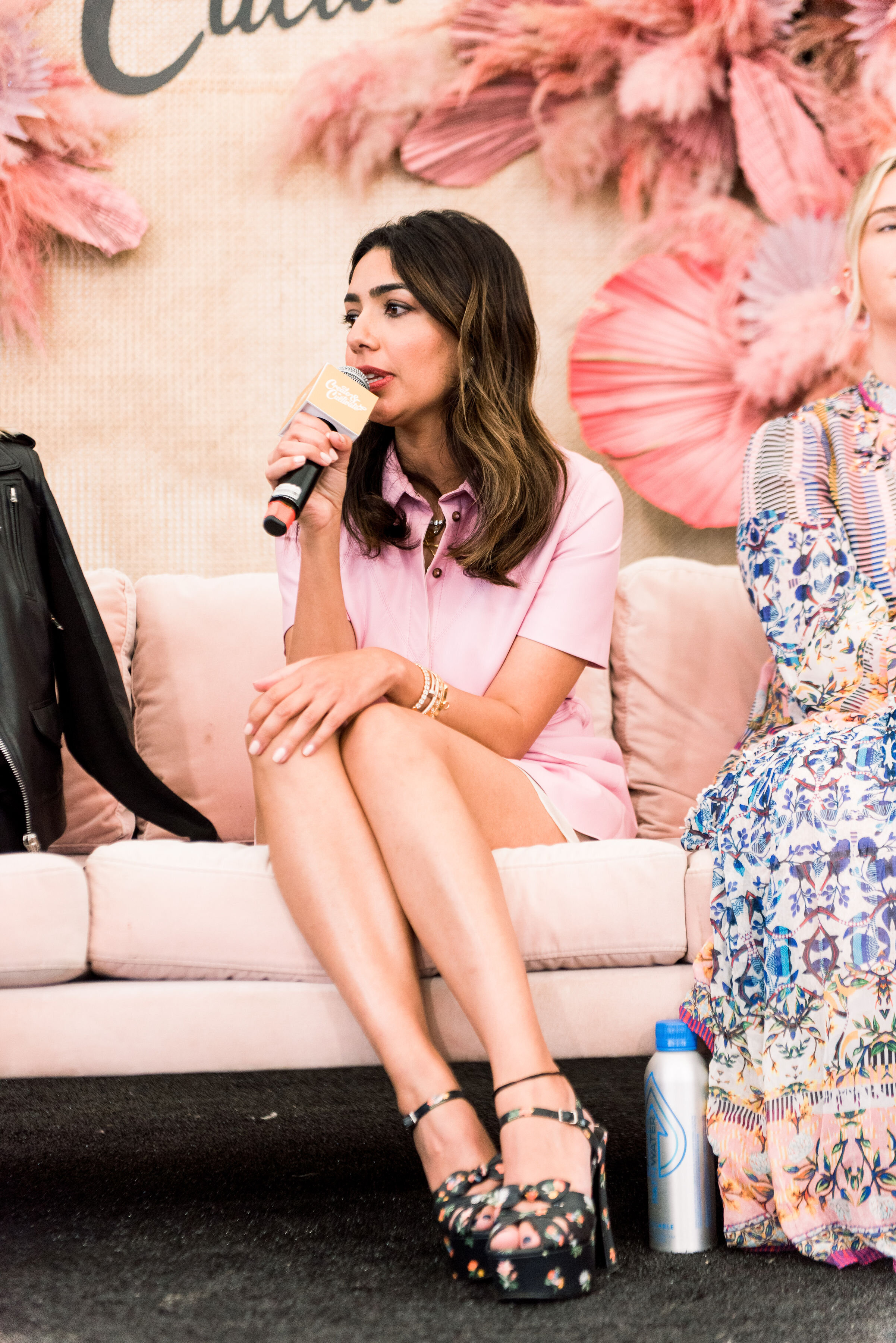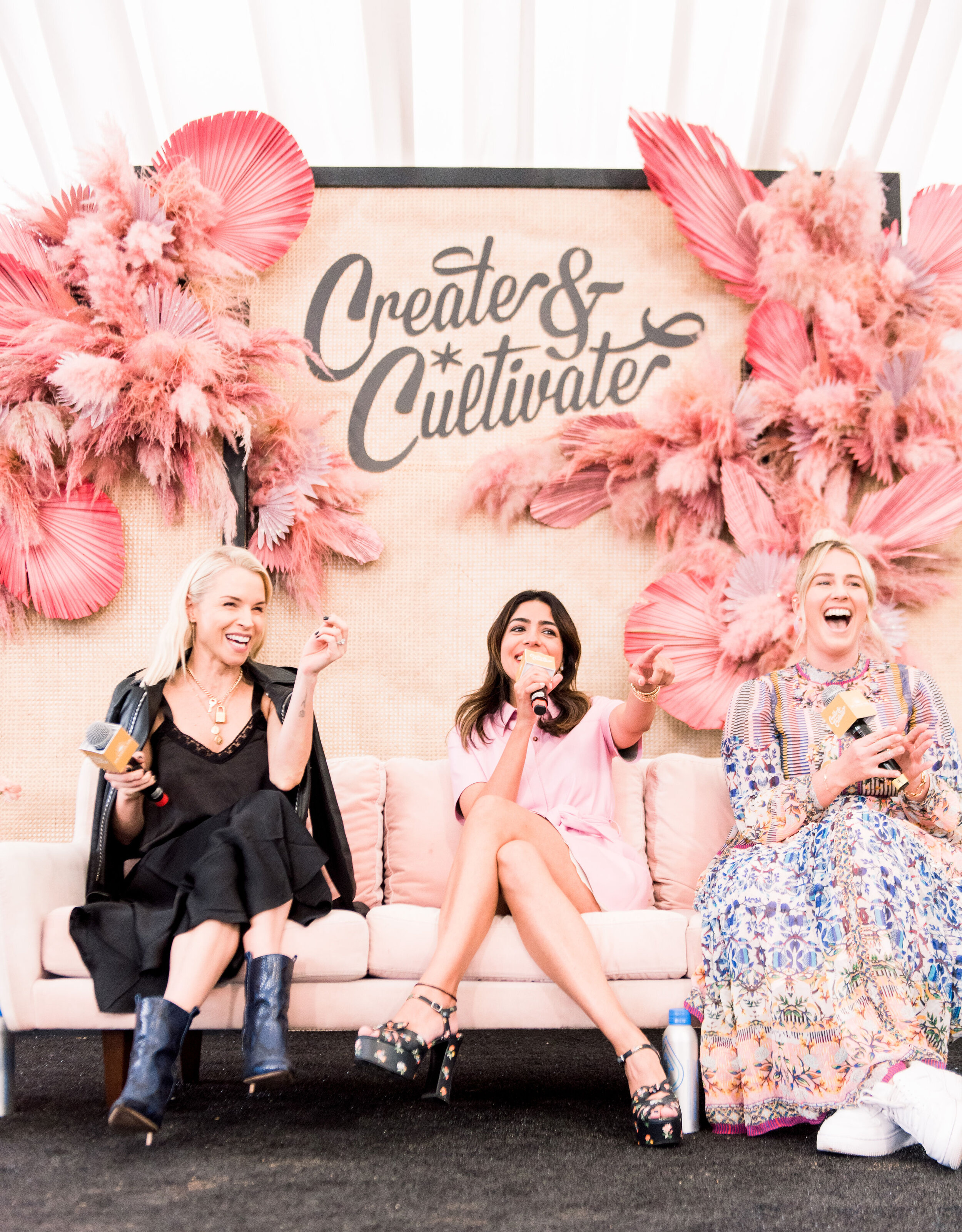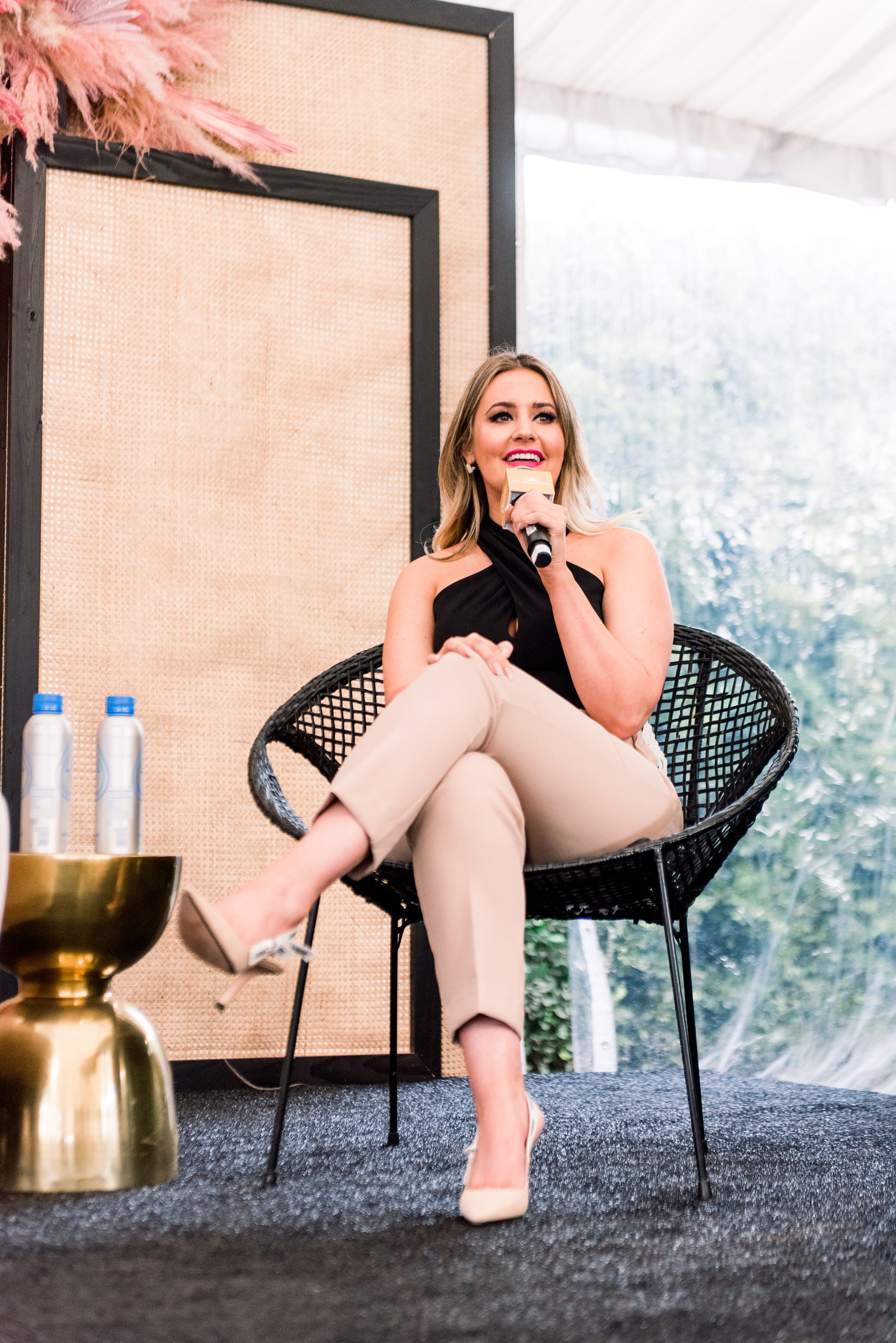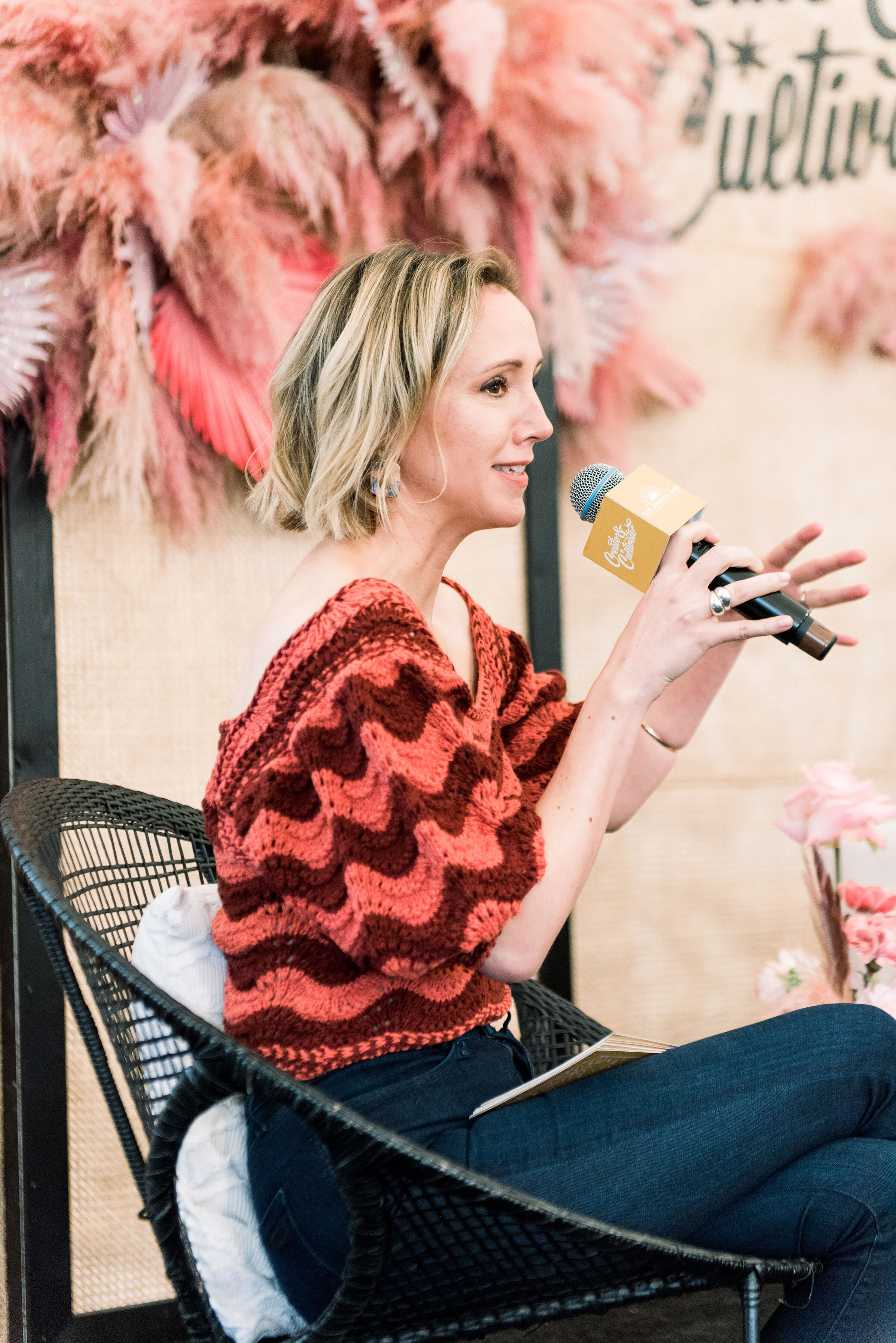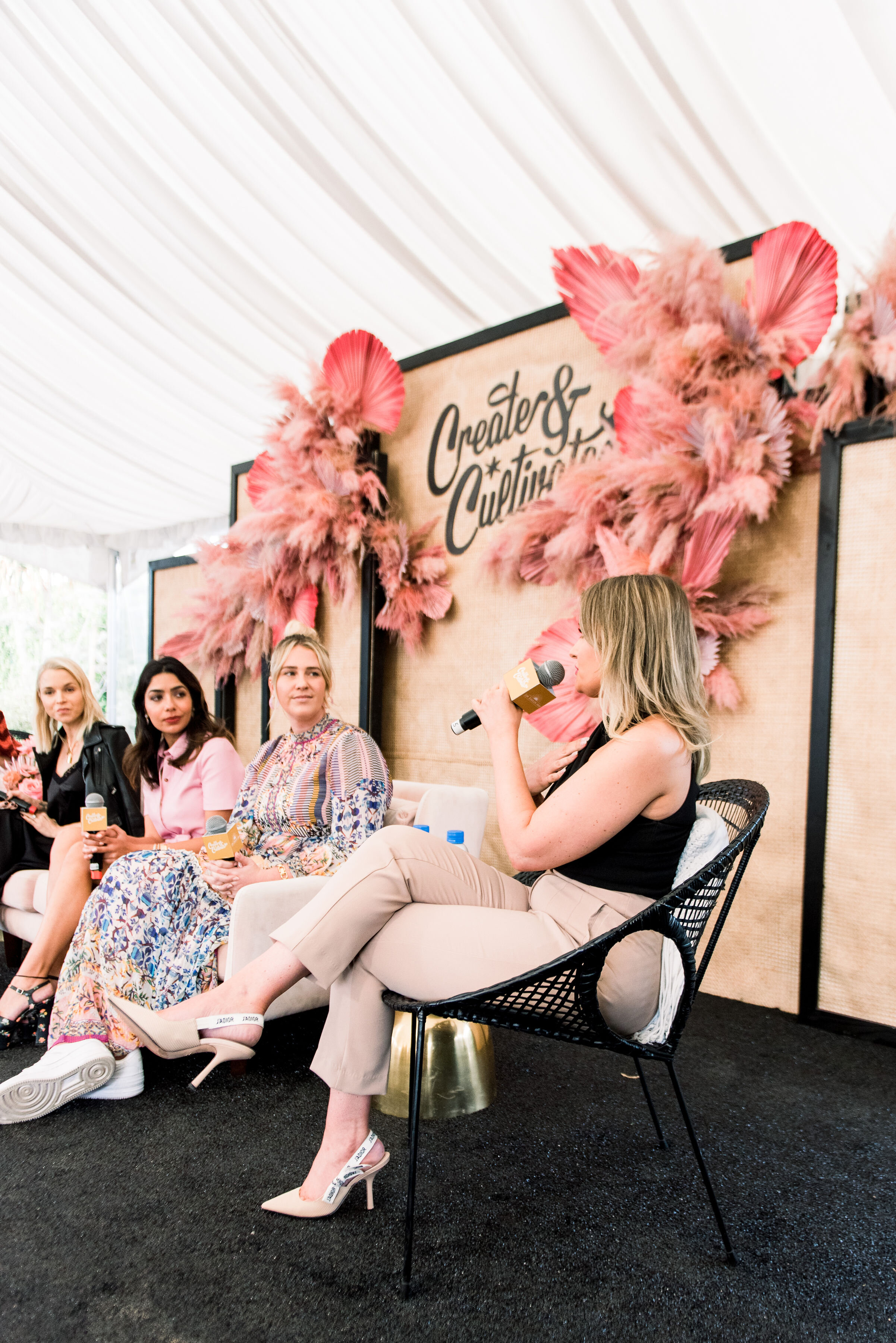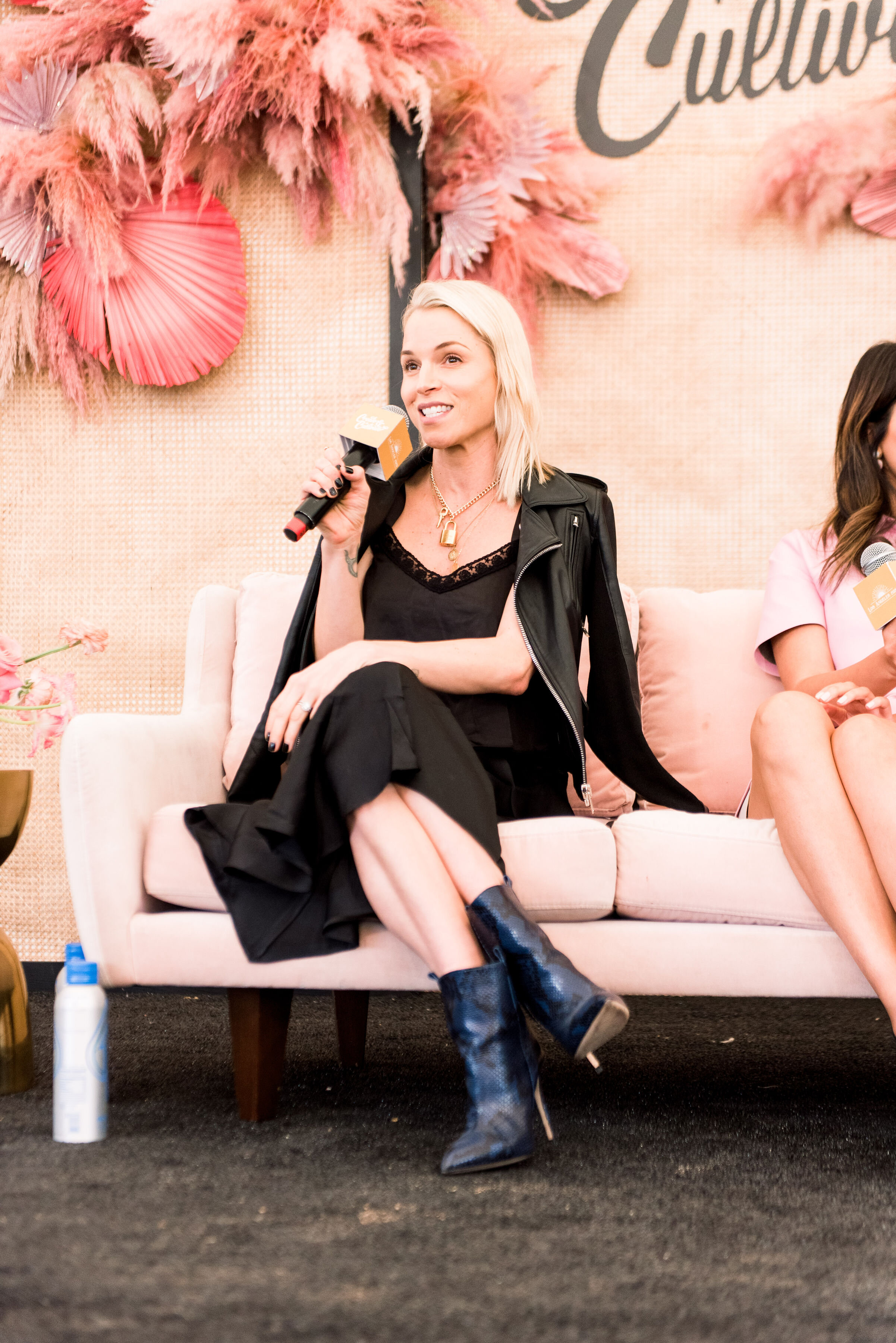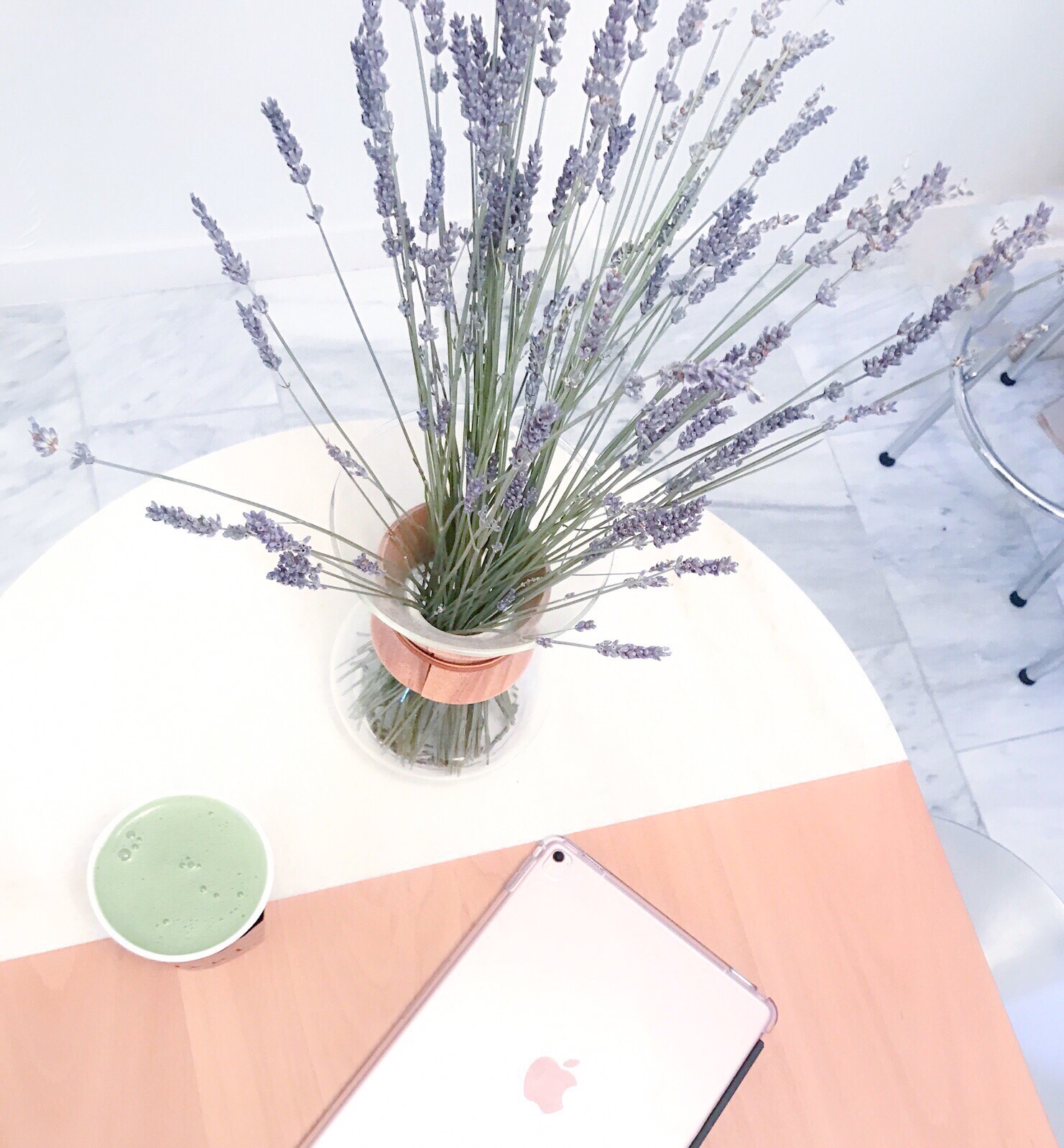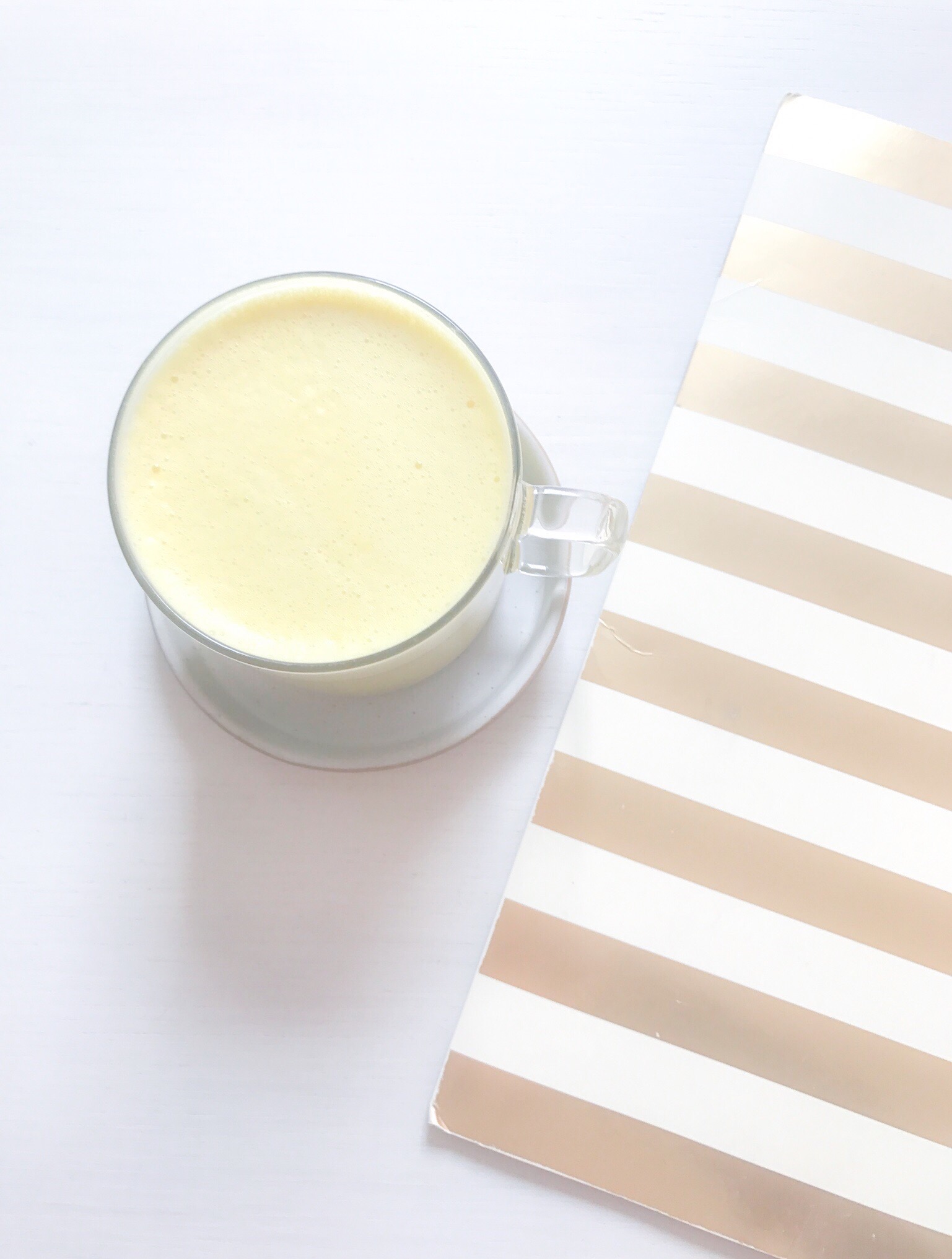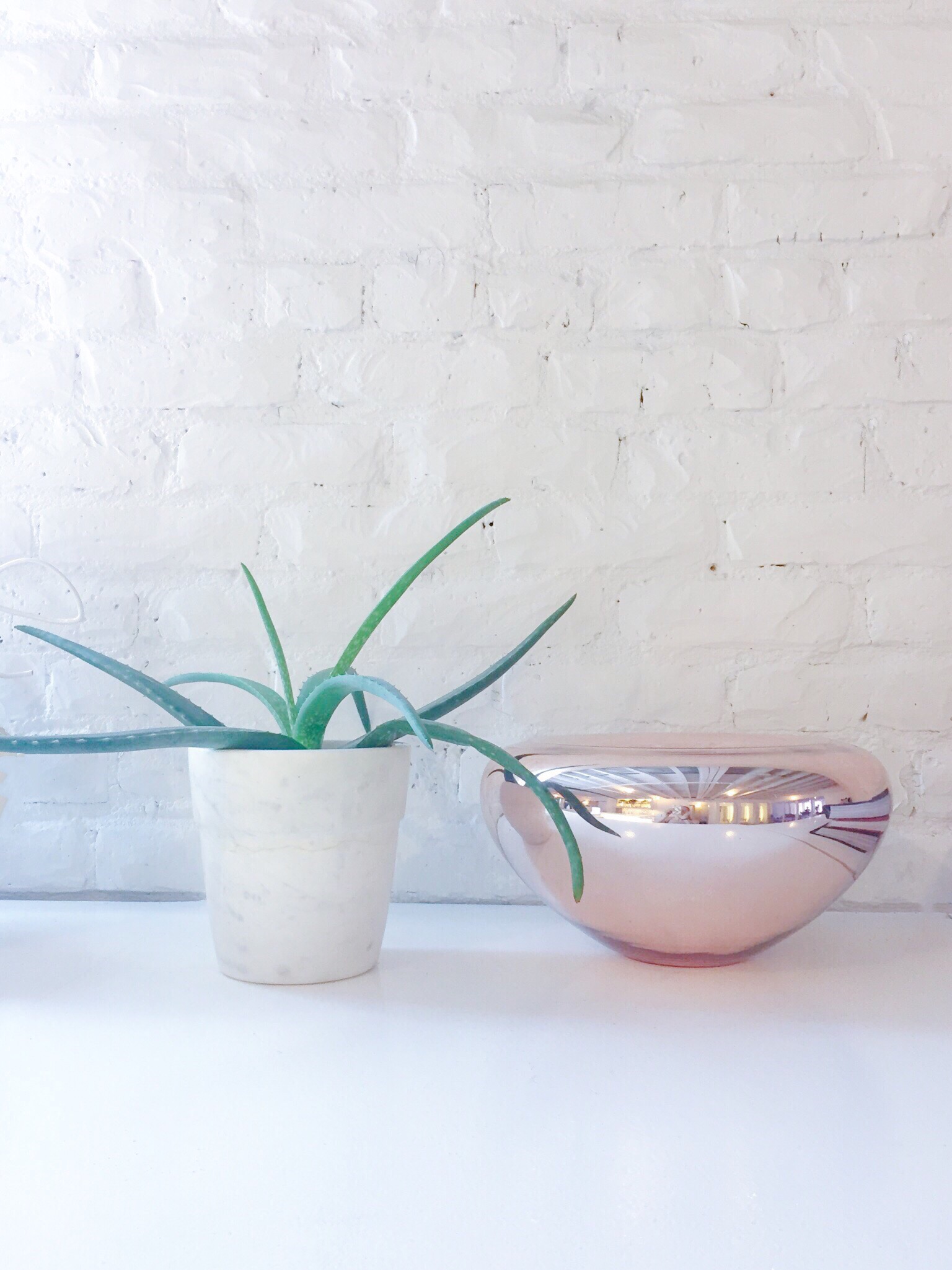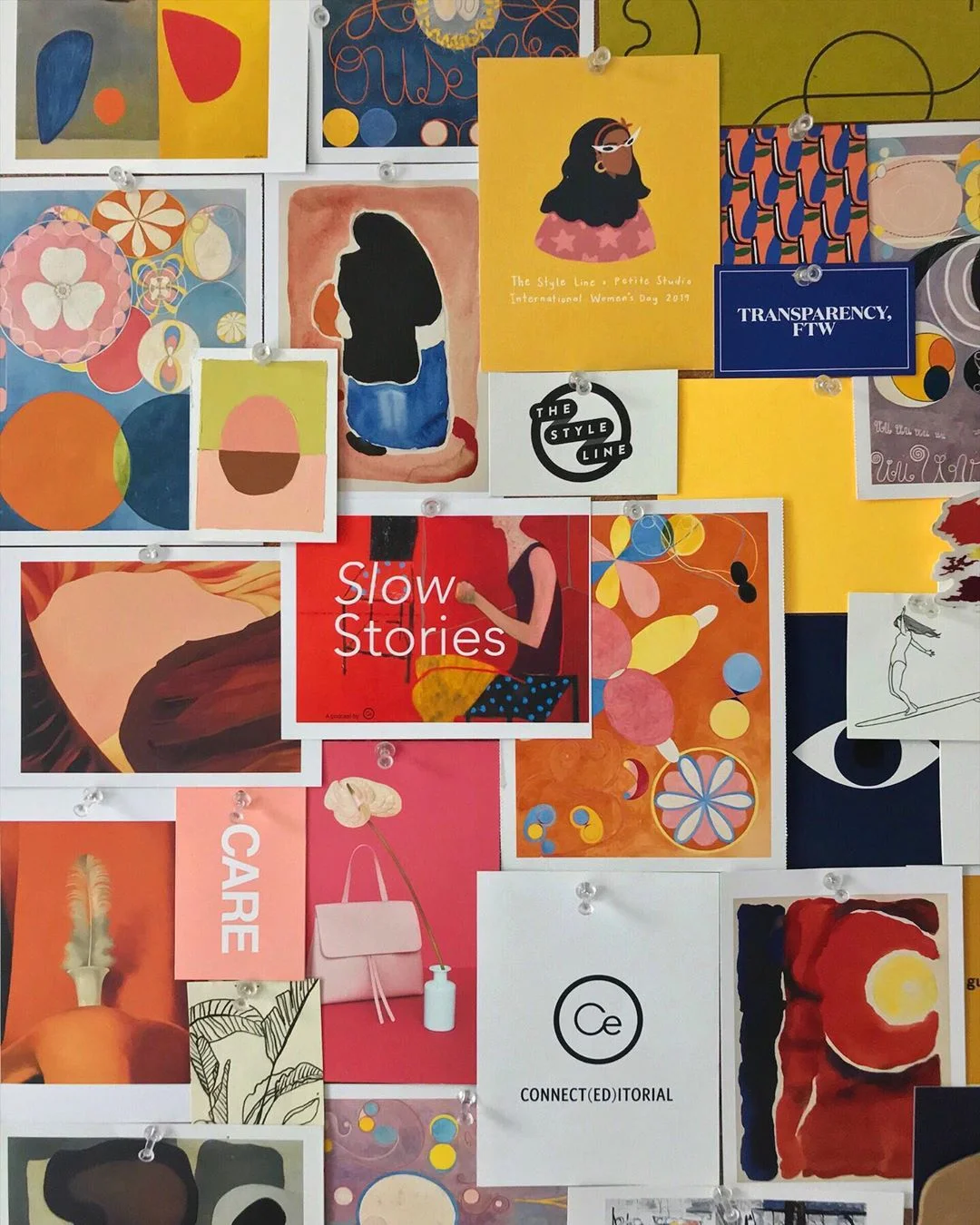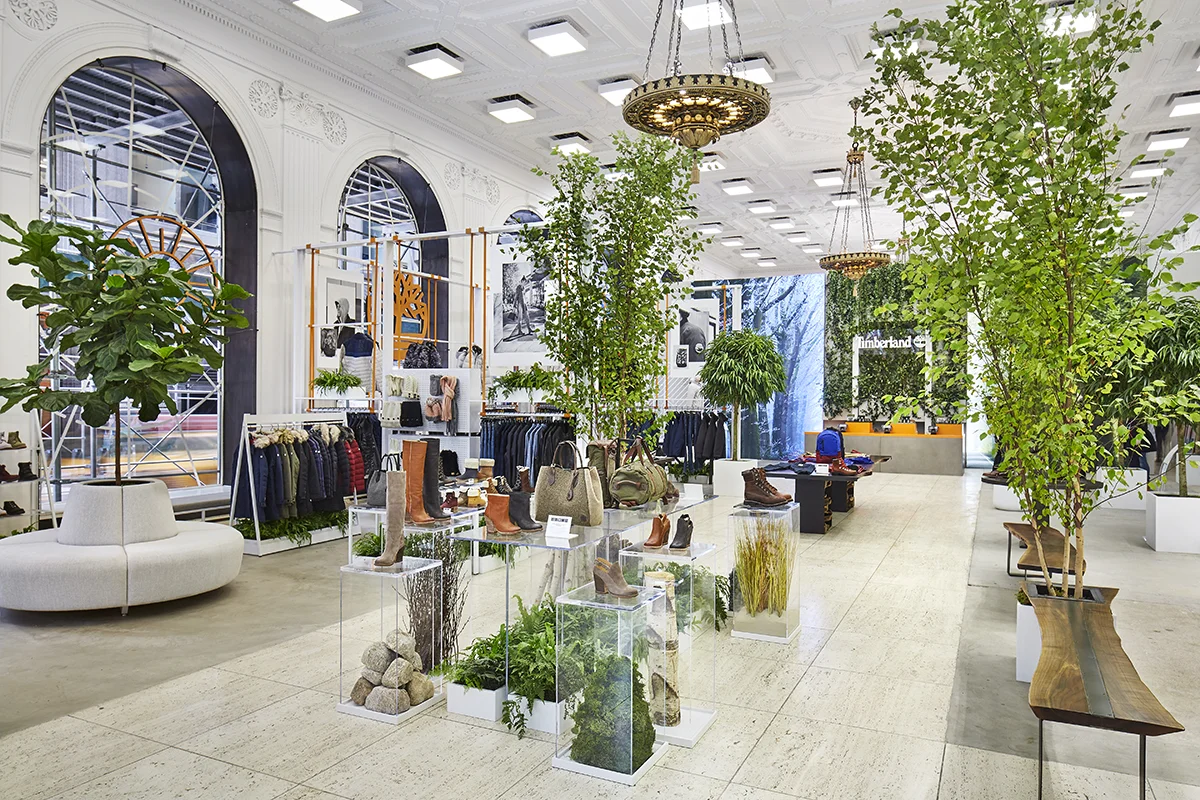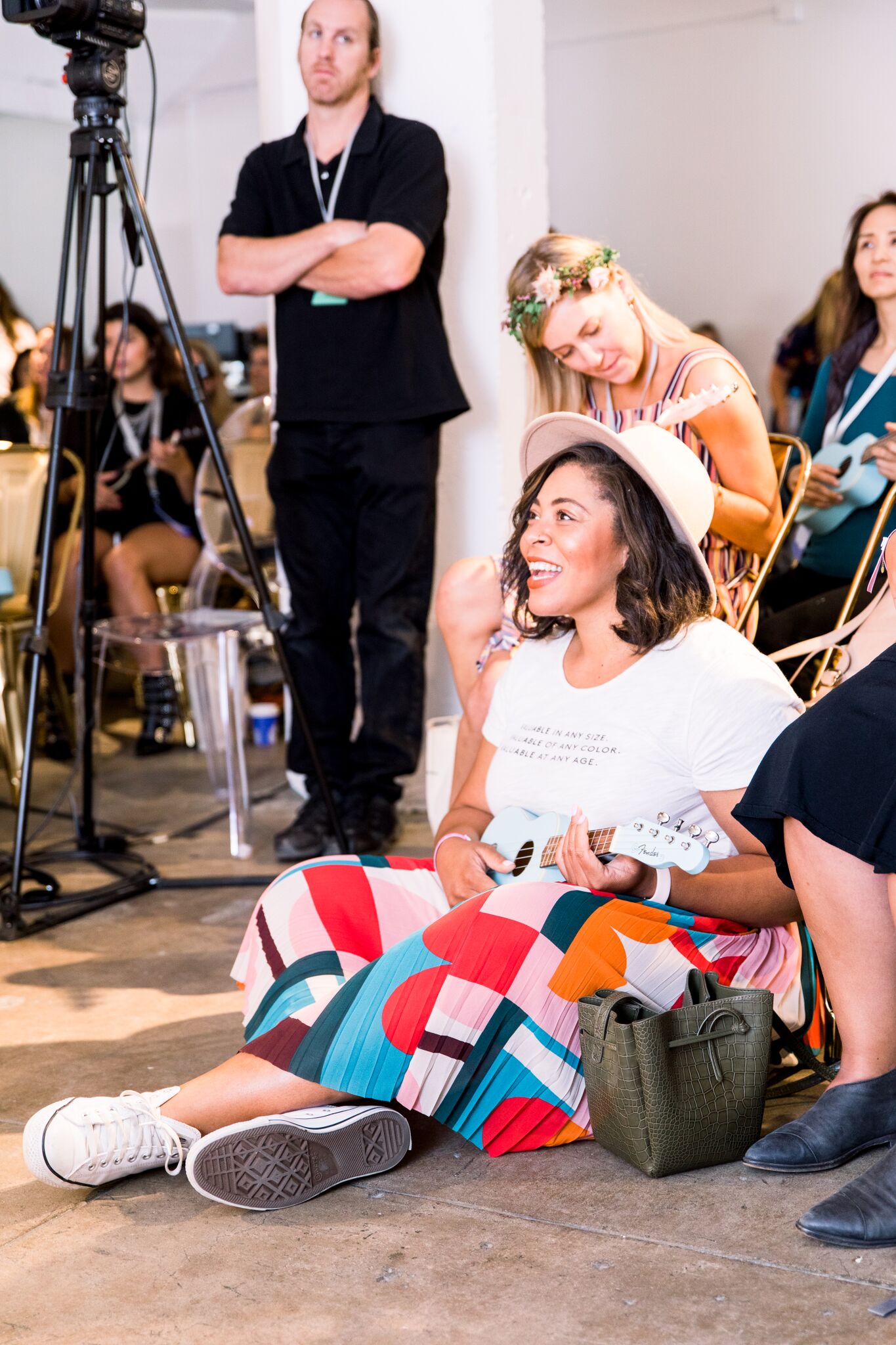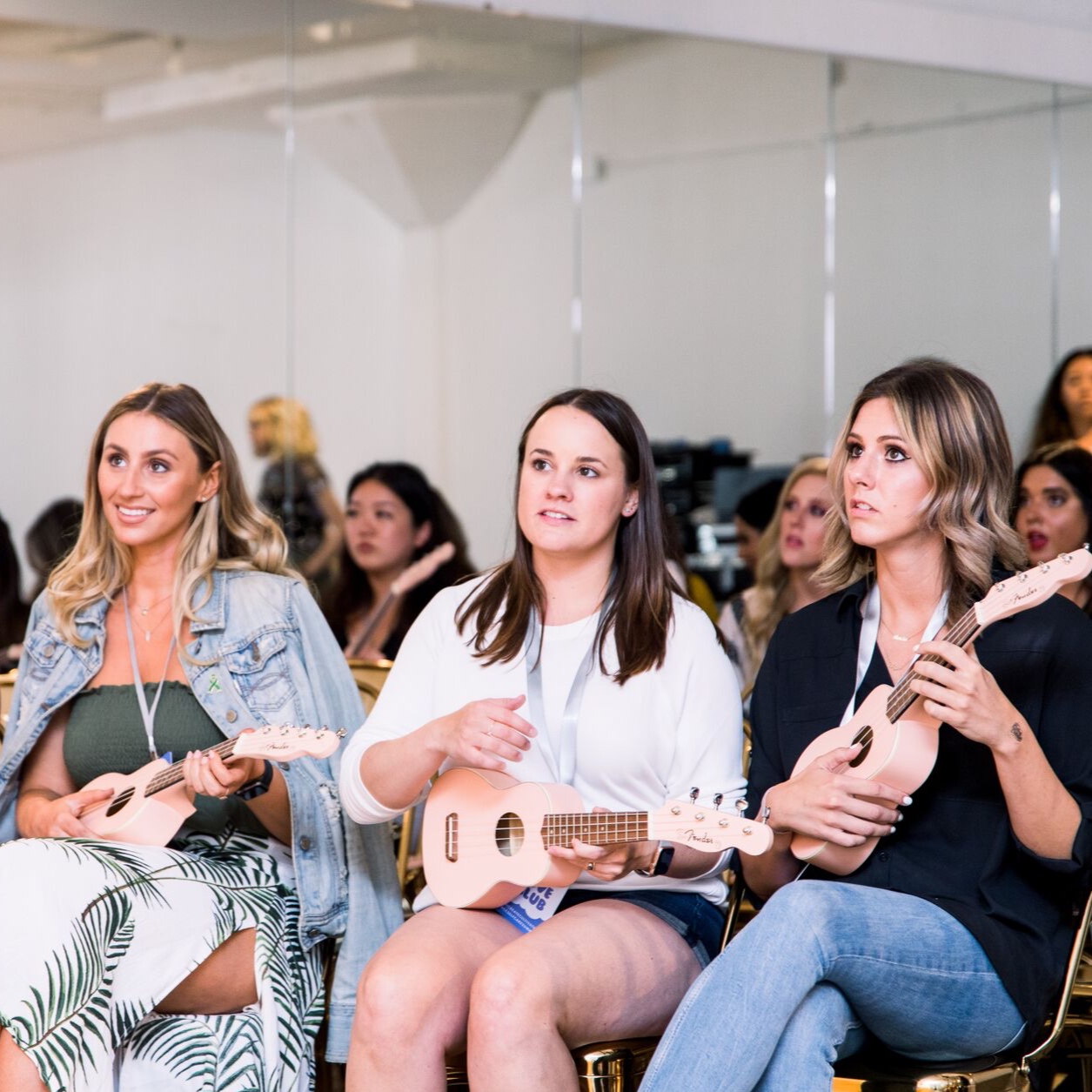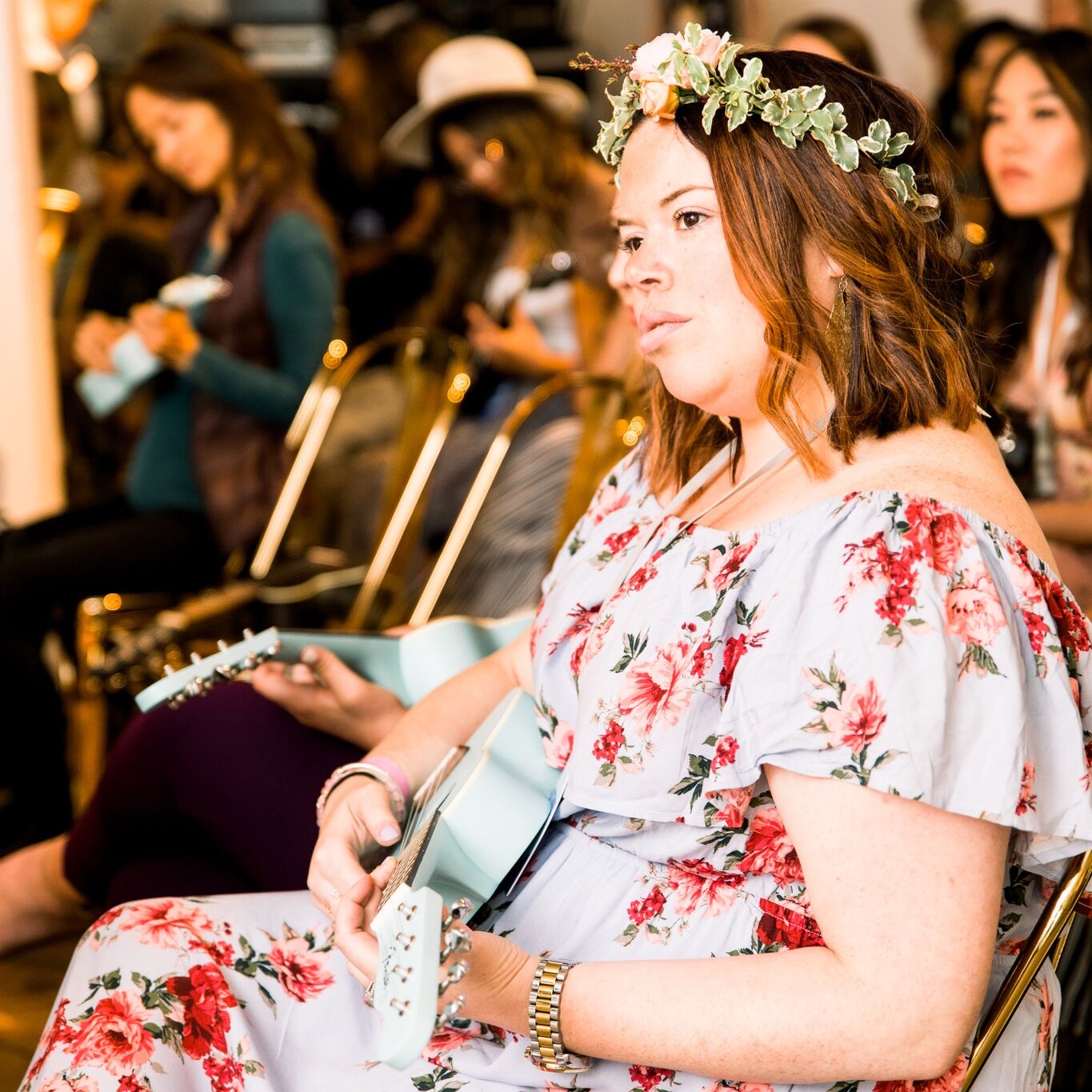5 Low-Maintenance Plants for Your Office That Clear the Air, Literally
Just add TLC.
Photo: Courtesy Ansel & Ivy
For Anum Tariq and Hiraa Khan, the co-founders of the female-founded and female-led plant delivery company Ansel & Ivy, being a "plant person" comes down to choosing the right plant for your space and your lifestyle. So how does that work exactly? Well, they’re like the Tinder for plants—they match compatible people with plants based on their level of commitment and environment.
Well, we called on the green matchmakers to help us find the easiest plants to take care of that not only spruce up the office but also clean the air too—yes, air-purifying plants exist and they’re way cheaper (and prettier) than the man-made versions. So, Tariq and Hiraa gave us the inside scoop on five air-purifying, low-maintenance plants to keep you company during your hectic workdays.
With just a little bit of TLC, these are some of the easiest plants to take care of and are sure to bring life a breath of fresh air to any office space.
Snake Plant, Sanseveria
$83
Maintenance: Low
Care Instructions: The snake plant is as easy as they come. She will do well in just about any lighting condition, including fluorescent.
Why It's Office-Proof: This trendy, architectural plant is hugely popular for every type of office, from start-up and corporate to home office. She’ll keep her cool, variegated leaves in low-light offices and is nearly indestructible if you forget to water her. She also rids the air you breathe of harmful toxins and debris.
Purifies the Air of: Benzene, formaldehyde, trichloroethylene, and xylene.
Peace Lily, Spathiphyllum
$83
Maintenance: Medium
Care Instructions: She’ll need a moderate amount of sun and regular watering to keep her happy.
Why It's Office-Proof: She’s one of the best air purifying plants out there. The nice thing about the peace lily is she’ll let you know when she’s ready to be watered because she’ll start to droop, but will immediately bounce back once she’s hydrated. So if you forget to water her before the weekend, just give her a drink on Monday morning and she’ll be back to her elegant, vibrant self. She’s also great for offices that crank up the air-conditioning since she’s more resilient to cold temperatures than other plants.
Purifies the Air of: Ammonia, benzene, formaldehyde, and trichloroethylene.
Rubber Tree, Ficus elastica
$83
Maintenance: Low
Care Instructions: She’s ideal for new plant parents. Sit her in a spot that gets indirect sunlight and only water when the soil has completely tried.
Why It's Office-Proof: The rubber tree is a popular alternative to traditional green foliage. She can grow to be very tall so her dark, glossy leaves will really liven up a bare office corner. She also purifies the indoor air of harmful toxins.
Purifies the Air of: Benzene, formaldehyde, xylene, and toluene.
ZZ Plant, Zamioculcas zamiifolia
$46
Maintenance: Low
Care Instructions: She’s one of the toughest plants out there. She’ll do well in almost any lighting condition, including fluorescent. She only needs to be watered when the soil has completely dried out.
Why It's Pffice-proof: The ZZ is ideal for dimly-lit offices. She’s perfect if you travel often and aren’t always at your desk since she’s nearly impossible to kill.
Purifies the Air of: Toluene and xylene.
Dracaena, Dracaena deremensis
$46
Maintenance: Low
Care Instructions: She does well in low light conditions and doesn’t need to be watered until her soil is completely dry.
Why It's Office-Proof: If your desk isn’t by a window and you still want some lush greenery, she’s your gal. She’s perfect for those who want a plant with benefits, without the care commitment.
Purifies the Air of: Benzene, formaldehyde, trichloroethylene, and xylene.
Love this story? Pin the below graphic to your Pinterest board.
This story was originally published on October 3, 2019, and has since been republished.
MORE ON THE BLOG
3 Quick and Easy Recipes to Make When You're Too Busy to Cook
Simple and delicious, what are you waiting for?
Here at Create & Cultivate, we know how busy life can get. Amidst a hectic schedule, it is far too easy to forget to take care of yourself in the mix. However, therein lies the contradiction: if you do not properly nourish your body, you won’t be able to perform anywhere near your best. So, we sat down with food blogger Kenzie Burke, who gave us a few of her favorite quick, easy recipes, and explained why it’s important to make time for food.
“I am a huge proponent of cook it once, eat it two or three times.”
—Kenzie Burke
Create & Cultivate: How can we food prep when we feel like there’s no time? What is a good hack?
Kenzie Burke: My mindset is that no matter how busy you are, there is always time to do things that matter to you. I understand what it is like to be insanely busy. Some days I cannot even manage to text one person back, but I know that I need fuel to perform at my best. It’s possible that you’ll have to stay awake 20 minutes later than usual to make tomorrow run smoother, or perhaps you swap out prep cooking in place of your evening Instagram scroll. Give yourself this gift. This probably isn't the answer anyone wanted to read but, where there is a will, there is a way. As mentioned before, I am a huge proponent of cook it once, eat it two or three times.
C&C: You are anti-diet—why? What is your food philosophy?
KB: My food philosophy is ‘make it a lifestyle.’ You’ve got to fall in love with your life. You have to wake up every day enjoying what you are doing or you just won't live a satisfying life. I believe this sentiment carries over into the foods we eat. You have to love what you eat and want to eat well. I’ve found that those who diet seem to fall off quite easily and feel limited and trapped. In my practice, I get to the root reasoning behind eating well. Why do you want to eat well? For your health? Body? Family? Taking care of your body is taking care of you.
You cannot show up as your best self for your friends, family, partner, and career if you don’t put your own oxygen mask on first. Find your why. To be more specific about what I love to put in my body, I really focus on whole foods. For lunch and dinner I try to make half my plate a veggie. I love to optimize digestion with food combining and plant-based food. I explore this concept further in my e-book as it has changed how I feel at an almost soul level. I feel like I vibrate on a whole new frequency.
3 Quick and Easy Recipes to Try This Week
Artichoke Heart Salad
Courtesy of Kenzie Burke
Ingredients:
Romaine lettuce
Cucumber
Chickpeas
Olives
Artichoke hearts
Red pepper flakes
Ingredients for the dressing:
3 large lemons
3/4 cup olive oil
2 cloves of garlic
Salt and pepper to taste
Note: This makes a big batch you can keep in your fridge and use throughout the week.
Directions:
Chop romaine into fine pieces, peel and cut cucumber. Plate lettuce and cucumber with chickpeas, olives, artichoke hearts, and top with red pepper flakes. For the dressing place all ingredients into your blender and blend. This dressing stores well in the fridge. Finish salad with this simple salad dressing.
Tropical Bub Smoothie
Ingredients:
Cup of frozen mango
1 banana
Chunk of cucumber
Spinach or lettuce
Chunk of ginger
1 date
Coconut water
Spirulina powder
Shake of cinnamon
Directions:
Place ingredients in a blender and blend!
Simple Chickpea Pasta
Ingredients:
Chickpea pasta
Handful of cherry tomatoes
1/2 an avocado
1/2 of a lemon
Drizzle of olive oil
Salt and pepper
Nutritional yeast
Directions:
Cook the noodles by following the directions on the package they come in. In a sauté pan; sauté the cherry tomatoes on medium heat in olive oil until they are soft.
Once the pasta has finished cooking plate the pasta with the cherry tomatoes, sliced avocado, and finish the dish with a drizzle of olive oil, squeeze of 1/2 of a lemon, salt, pepper, and nutritional yeast.
This dish is ready to eat. It is also good cold.
Love this story? Pin the below graphic to your Pinterest board.
This story was originally published on September 5, 2019, and has since been updated.
MORE ON THE BLOG
I Tried This Wellness CEO’s Morning Routine to Set Me Up for Success in Self-Quarantine
You’ll want to write this down.
Photo: @Sacha.Strebe
There’s a reason why the most successful people in the world have a morning routine. It’s the only time in our “always-on” culture where we can enjoy a few moments of sacred silence before the outside world demands our attention. If you’ve never really thought about turning your A.M. into a ritual, then now, more than ever, is the time.
A consistent morning routine can help establish a sense of stability and control. And in a time where it can feel like a lot of things are out of our hands, that idea is incredibly comforting. Of course, creating a morning routine sounds good in theory, so before you get started, just be aware that it can take some trial and error to nail down the one that suits your life, or want to stick to. And it doesn’t matter what that ritual is—there are no rules here—it’s entirely individual.
But, if we are going to take notes from anyone, it will be from the people who run multimillion-dollar businesses, oversee international teams, and have built brands from scratch, because let’s face it, they must be doing something right to have the energy, determination, and organization to pack as much as they do into one day without burning out.
But, if you haven’t given thought to how you spend those first few hours, take heed from former Target exec and now CEO of Rae—evidence-based vegan supplements made for women making moves—Angie Tebbe. Despite a jam-packed schedule, Tebbe takes time every morning for self-care, mindfulness, and coffee!
Photo: Courtesy of Rae Wellness
As someone who has really struggled with sticking to any semblance of a schedule since self-quarantine began, I wanted to give Tebbe’s morning routine a spin and see if it helped set my day up for success too. For context. I typically get up at 8 AM (it was 6:30 AM pre-quarantine), I have a cup of earl grey tea while I’m checking emails, I take a shower and then jump into my sweats or exercise gear (in the hope it will inspire me to workout later). I have been known to work from my dining room table from 9 AM until 7:30 PM without a proper break and snacks in between. It’s safe to say my water intake is at an all-time low too. Can anyone reading this relate?
So, I was ready to start creating a morning habit that could not only help my health, but also quell my stress and anxiety, so I can take charge of my to-do list and power toward my goals in a better mood. Read on to learn how Tebbe uses the first hours of sunlight to give her day the best chance of success, then discover how I went about incorporating it into my own routine.
(Spoiler alert: It greatly impacted my mood, metabolism, and stress levels.)
“I
no longer check my emails in the morning; it has helped me be less reactive and more present and patient as I start my day.”
—Angie Tebbe, CEO, Rae Wellness
CEO of Rae Wellness, Angie Tebbe’s Morning Routine
Wake Up Before Everyone Else
I always used to find mornings stressed and rushed, until I realized how important it was to create rituals that work for you. Since becoming a CEO, I have made intentional choices about mindset and routine to make sure I show up for my family, team, and partners. I wake up at 5:45 AM to ensure I have a few moments to myself before my household begins to rise, beginning with my 5-year-old at 6 AM! I find that I am my best when I can first ground myself in gratitude, especially right now given everything going on in the world.
Practice Gratitude
I meditate every night, so I save the deeper rituals for then but in the mornings I practice gratitude for two-three minutes. A mentor once taught me—visualize the most important moment you remember with your partner, and the first time you met your children. What did that feel like, sound like, etc.? It helps me plant my feet and ensures I’m in the right headspace to approach the day.
Hydrate, Hydrate, Hydrate
I drink about 20 ounces of water every morning (the first few sips are always with our Hydration Drops) before I allow myself to drink my Americano with our Vegan Collagen Boost Powder, cream, and monk fruit.
Photo: Courtesy of Rae Wellness
Fast Until 9 AM
I have experimented with intermittent fasting a bit and typically fast from 6 PM until 9 AM—15 hours is how I feel my best. The first thing I have in the morning is coffee at 9 a.m. and then I’ll drink an almond milk and pea protein smoothie—I blend it with ice. It keeps me going for three hours until lunch at 1 PM
Do a Workout
I like to workout in the morning, but being at home has changed my routine a bit. I typically work out on weekdays (running or spinning), and on weekends I’ll spend the mornings with my husband and boys instead. Due to the quarantine, I’ve been working out around midday and taking a walk with the family after dinner. Getting it in is the most important part so I try not to worry if the time slot changes given everything we are all trying to juggle right now.
Don’t Check Your Inbox
I recently changed my own habits on this, and no longer check my emails in the morning; it has helped me be less reactive and more present and patient as I start my day.
Tackle Important Tasks Early
I minimize distractions and give myself a couple of completely uninterrupted hours to work in the morning before any meetings. I find that I’m more productive and “fresh” to tackle challenging questions or needs of the business right away. As the day progresses, I make sure to keep my energy up with lots of water and protein. At lunch, I take our multivitamin, which gives me energy through the afternoon.
My Verdict
Name & Title:
Sacha Strebe, Editorial Director, Create & Cultivate
The Routine:
I tried Angie Tebbe, CEO, Rae Wellness’ AM ritual for one week!
The Products:
Rae Wellness Hydration Drops
Rae Wellness Vegan Collagen Boost Powder
Rae Wellness Multivitamin
Rae Wellness Destress
Rae Wellness Energy Drops
Rae Wellness Sleep
The Goal(s):
I have always been so intrigued by the morning rituals of successful people. CEOs are some of the busiest people on the planet and from all of the articles I’ve read, they swear by an AM ritual to kickstart their day and maximize their time. Upon reading Tebbe’s morning routine it immediately reminded me of my own.
I am very ritualistic, especially since becoming a mom, so a lot of her steps resonated with me but since quarantine began, my schedule is entirely out of whack so I wanted to test out Tebbe’s to reintroduce structure and ritual in a bid to bring about some normalcy in this “new normal.”
My end goal in testing Tebbe’s morning routine was to enhance my energy and mood, relieve stress, and encourage better sleep.
My Week in Review:
Tip 1: Wake Up Before Everyone Else
Since I don’t have to commute to the office in self-quarantine I have been sleeping in much later so I’ll admit that waking up at 5:45 AM was a struggle. But I’m never going back (although I may schedule it slightly later to 6:30 AM instead!). I absolutely love having my own time in the morning before the family wakes up. It’s the only part of the day where I can truly let my mind relax, there isn’t anyone demanding anything from me—it’s just me, the sunlight through the window, and a cup of tea.
Tip 2: Practice Gratitude
This is something I have always done with our family but I haven’t ever formalized it into my AM routine. I now use that quiet time before the house wakes up each morning to run through what I’m grateful for and sometimes I will write them down, too. It has really helped me approach each day with intention and mindfulness, something I think I took a little for granted before.
Tip 3: Hydrate, Hydrate, Hydrate
I loved starting my morning with 20 ounces of water and the Rae Wellness hydration drops with pure and powerful hyaluronic acid and electrolytes. (I also added in their energy drops which was so much softer on my stomach than traditional Vitamin B tablets). I struggle drinking water normally so this ensures I’m getting maximum hydration with every drop. I also found that prioritizing water first thing before any other liquids are key to making sure I’m hydrated throughout the day. Tebbe also inspired me to get back into making green smoothies each morning. I add the Rae Wellness Vegan Collagen Boost Powder into the mix with baby kale, spinach, blueberries, protein powder, and rice milk. I’m a vegetarian, so I’ve been searching for a vegan option that isn’t bovine for ages and this one is also flavorless so it’s a win-win.
Tip 4: Fast Until 9 AM
While most of Tebbe’s morning routine looked reasonably simple to achieve, I wasn’t sure how the intermittent fasting would work for me. Our family usually eats around 8 PM (or later since self-quarantine), so fasting from 6 PM was tricky for me. But on the nights that I did, it definitely helped my sleep overall because it allowed for proper digestion before going to bed. I also went to bed earlier, which in turn saw my energy levels increase the next day. I definitely want to continue eating our dinner earlier so I can fast for 15 hours like Tebbe each day. It made enough of a difference to warrant continuing it and turning it into a habit—the research behind intermittent fasting is compelling. On the nights I couldn’t sleep, I took the Rae Wellness sleep capsules with melatonin (and they worked) but I found on the days I
Tip 5: Do a Workout
I’m glad that Tebbe switched her morning workout to midday or later since quarantine because while I have been working out more, I have never been able to motivate myself to exercise first thing. I definitely prefer the afternoon or early evening. Like Tebbe, I have also been less focused on “working out” and instead, making sure I incorporate some type of movement into my day. It has dramatically enhanced my mood, my metabolism, my sleep, and my energy.
Tip 6: Don’t Check Your Inbox
I used to practice this but I got out of the habit since self-quarantine. Before I started Tebbe’s routine, I would wake up, grab my phone, and dive into emails while I was still sitting on the side of my bed. My poor brain hasn’t even had a chance to wake up yet and I’m already bombarding it with tasks and requests. So, now I’ve reverted back to the “no emails” rule in the morning, and instead, I focus on mindfulness practice, setting myself up for success, both physically, emotionally, and spiritually. It’s the one part of the day that belongs to me! It’s a game-changer.
Tip 7: Tackle Important Tasks Early
Most mornings I am pretty focused early, but since I have been waking up earlier and incorporating Tebbe’s gratitude practice, my brain is sharper and laser-focused. At 9 AM, I sit down at my dining table come makeshift office during quarantine with my decaf latte and really focus on urgent tasks for a good hour and a half before our seniors meeting at 10:30 AM. It has been so impactful. I definitely have fewer distractions in the morning from my family and team (they’re usually all logging on) so I have been able to get so much done during that time period. I will definitely be incorporating this into my morning routine moving forward.
Final Verdict:
I am so grateful for Tebbe’s AM tips. I feel like I have more structure, more focus, and more gratitude this past week which is especially needed while we navigate this “new normal.” It’s also a realistic routine to emulate, unlike some other CEO morning routines I’ve read about so I’ll definitely continue to incorporate them into my own morning ritual. I loved all of the Rae Wellness products too, especially the hydration and energy drops—so genius! The Destress capsule and Multivitamin (I loved the mint flavor) was also a great addition to my daily supplement line-up—they’re also incredibly affordable, too.
While I loved mimicking a CEO’s morning routine for a week, ultimately your morning should be exactly that, your morning. So don’t feel like you have to copy anyone else’s routines and expect the same results. The goal here is to find a ritual that works for you and it will change as you and your circumstances change. Self-quarantine is an emotionally and mentally challenging time for all of us, so be kind on yourself, do what works for you, and your personal health and wellness will improve, too.
SHOP MY RAE WELLNESS FAVORITES BELOW:
Rae Wellness Multivitamin
$14.99
Rae Wellness Hydration Drops
$14.99
Rae Wellness Destress
$14.99
Rae Wellness Hydration Drops
$14.99
Rae Wellness Vegan Collagen Boost Powder
$14.99
MORE ON THE BLOG
2020 Vision: How 4 Women Are Approaching Wellness in the New Decade
Self-care isn’t just a buzz word.
This post is in paid partnership with iHerb.
It’s hard to believe that a decade ago, Google search interest in “self-care” was at its lowest. Now, the most popular buzz word of 2019 is feeling, well, a little burnt out. Ironic, isn’t it? But just because the word is a little overused, doesn’t mean the physical act of it is. In fact, self-care has largely contributed to the wellness market boom which is now valued at a whopping $4.2 trillion, having grown 12.8% in the last two years. And it’s not just outside of work either. The global corporate wellness market is also estimated to reach $66 billion in 2022 because news flash: healthier workers are more productive. Who knew?
Thanks to more people choosing to pursue activities that promote physical and mental well-being, self-care is now being seen as a form of necessary healthcare and not a selfish behavior as it was once viewed in the past. After all, if you don’t put your oxygen mask on first, you can’t help others.
But it’s not always easy to find the time and wellness can be expensive. iHerb understands the challenges that come with navigating the winding road of wellness. That’s why they provide wellness solutions for all the key aspects of your life, including supplements and vitamins, sports nutrition, herbs and homeopathy, and self-care essentials like skincare and body care, at prices we can all afford.
We partnered with iHerb for our 2020 Vision panel at the recent Los Angeles Conference and asked four women—Britney Vest, Dr. Deepika Chopra, Lauren Kleban, and Kirbie Johnson—to share their thoughts on wellness in the new decade.
Read on to hear some major realness from the conversation and be sure to comment below to share your thoughts on wellness in 2020, too.
2020 Vision: A Conversation on Wellness in the New Decade Powered by iHERB
On body positivity…
“For me, body positivity is truly learning to love yourself every day exactly as you are in this moment” - Britney Vest
“The movement has really blown up, but there is still so much to be done.” - Britney Vest
On weight loss and body positivity...
“They can exist together, it is not a bad thing to want to improve and want to change.” - Britney Vest
On work as self-care…
“Work, for me, is self-care. It makes me feel valued and valuable.” - Kirbie Johnson
On taking work home...
“You're devaluing yourself because you are only paid to work from 9 to 5.” - Kirbie Johnson
On change in the beauty industry...
“We’re switching from, ‘You need this to look beautiful,’ to, ‘This will make you feel good or will help someone in need.’” - Kirbie Johnson
On partnering with brands authentically...
“No matter what it is, I typically only work with brands that I already have in my home that I am already using that I am authentically connected to.” - Britney Vest
On wellness on social media…
“Being able to celebrate yourself on social media is so important.” - Britney Vest
On improving…
“Remember: It is not a bad thing to want to improve yourself and want to change.” - Britney Vest
On not taking on too much...
“The way you can achieve wellness is by realizing that you can’t do everything at once.” - Dr. Deepika Chopra
On being an optimist…
“Being an optimist doesn’t mean skipping around fields or always having a perfect day, it’s about being someone that sees setbacks as temporary and knowing you have the power to overcome them.” - Dr. Deepika Chopra
On mental health…
“I learned very quickly to keep blinders on—don’t be in a position where you compare yourself to others.” - Lauren Kleban
“We have our physical health and our mental health to take care of. It's what makes us all human.” - Dr. Deepika Chopra
How to Enhance Your Mental Wellness at Work (and Be Happier and Healthier)
You don’t even need to be in an office to practice these.
Wellness at work. For some, wellness is work and work is wellness. For others, wellness and work rarely enter the same sentence. As a holistic psychologist, I am a strong advocate of creating wellness in all parts of life. The average person spends the majority of their life at work, and about half of the population cites work as their most significant stressor. Bringing wellness into the workplace has become more important than ever as workplaces become increasingly demanding and the line between work and home becomes blurred.
We spend much of our time in places of work, engaging in work tasks, and thinking about work, so a large portion of our mental wellness is wrapped up in our work lives. In contrast, most wellness tips, tricks, trends, and routines are geared towards the time we spend outside of work. Our healthy breakfast nutrition, our morning workout class, our evening fun with loved ones, our post-work yoga class, our morning meditation, and our skincare routine all get more attention than the important topic of how we cultivate wellness at work.
I’m a supporter of all of those healthy choices we make outside of work, as I believe that every part of our health is inherently connected. And, to be truly holistically healthy and thriving, we have to intentionally integrate mental wellness into our workday as well.
While there can be many uncontrollable aspects of one’s work life, we all have many access points for enhancing our own mental wellness that exist within our power. Read on for five scientifically-backed strategies that are always accessible to us to boost mental wellness in the work day. Let’s start with ways to enhance mood and mental wellness even before getting to work.
Thankful Route to Work
Each day many of us embark on a commute to work. Some of us drive long distances, some cram into bustling subways, some have short strolls, and some simply move rooms in their home. Whatever our journey to our work day entails, there’s an incredible opening of opportunity to make it meaningful part of our day. If we intentionally note three things we are thankful for along the path to work, we are choosing to set up our work day mindset in a positive tone. It could be your coffee in hand, the smile on a fellow commuter's face, or simply your own body for getting you where you need to go. Research shows that bringing thankfulness into awareness in the moment releases feel-good chemicals in the brain, setting you up for a happier work day.
Here are some top tips for how to maintain, sustain, or rejuvenate mental wellness throughout the workday:
Pause
Mindfulness has become a popular workplace wellness strategy, and for good reason. Taking a moment to intentionally bring awareness to the breath actually deactivates our stress response and activates our emotional and cognitive processing center. Even just becoming aware of what it feels like in the body to take four long deep breaths is associated with increased joy and productivity and decreased stress.
Hydrate
Our brain and body need fuel to function optimally. If we want to feel well during our work day, we need to fuel well. While nutrition plays a crucial role in our mental wellness, hydration is the first step. When we are dehydrated, our brains become anxious and stressed. Drinking water plentifully throughout the day makes for an easy and impactful wellness boost.
Connect
Our brains thrive off connection. When we feel connected, the same parts of our brain that register physical safety light up. If work entails being around others, take a moment to smile at someone, or exchange a friendly conversation with eye contact. These little moments of connectivity actually activate the reward circuitry in the brain. If there’s no one around to connect with, turn to the surroundings. Creating a connection with nature daily comes with documented mental health benefits, such as calming our nervous system. Try smelling the plants in the work space or taking a quick break to walk outside and simply look up at the sky (that’s my personal NYC nature connection).
While many don’t have a distinct end point to the work day anymore, it’s important to mark the work day at some point in the evening to honor the efforts of the day and set intentions for the next day:
Attend to Good
Attention is like a spotlight in the brain - whatever we shine it on becomes brighter. By intentionally noticing the good in the day, the brain is being trained to see more good in the future. Even on a challenging day, noting a few small glimmers of gold in the day allows the brain to calm it’s stress response and makes the brain more likely to look for goodness in the next day.
When we integrate mental wellness strategies into work life, we not only enhance our overall life satisfaction and mental health, we also enhance our functioning, productivity, and creativity at work.
By: Ellie Cobb, Ph.D., Holistic Psychologist, Grounded & Gold
About the Author
Ellie Cobb, Ph.D. is a Holistic Psychologist, Mindfulness & Meditation Teacher, Director of Psychology for Thankful, and Founder of Wellness Company *Grounded & Gold.* She is a published researcher and author, and she teaches, writes, & gives talks and workshops around the country to spread her passion for empowering others to improve their own wellbeing through scientifically-back mental wellness & holistic health.
This post was originally published on October 10, 2018, and has since been updated.
MORE FROM OUR BLOG
Slow Stories—Literally, Slow Down: How Taking a Content Break Can Lead to Successful Storytelling
The turtle wins the race.
Photo: Courtesy of Slow Stories
Ahead of the season three launch of the Slow Stories podcast, I'm thrilled to return to our namesake column after a summer-long hiatus. When I wrote the most recent article in July, I was on the tail end of a period where I had essentially been operating on autopilot. Naturally, this ran counter to the idea of slow content and the themes that we explored last season on the podcast.
While my work certainly didn't stop this season, taking a brief pause from this particular initiative allowed me to recalibrate how I am able to fully implement a slower and more thoughtful approach to content across my personal and professional channels. As things kick into high gear for the upcoming fall/holiday content craze, I'm sharing a few things to think about if you're planning to rethink your content strategy during a high energy time.
Create Context
The most direct way to set the tone for a slowdown in content is to establish context as to why your audience can expect changes. This can range from a formal announcement outlining concrete details and timing of a content hiatus, or if you're unsure as to how long you need to recalibrate, subtle changes in your content calendar over an extended period. If you're a personality or individual content creator, I also encourage revisiting my April article, which also touches on the importance of boundaries. At the end of the day, whether you're a personal brand or business, it is at your discretion to decide how much you share online about the choices you're making within your company.
Adjust Your Posting Cadence
If you don't want to shock your followers with an unexpected silence, ease them to the changes by establishing a routine that is more in-line with your current content calendar. For instance, if you're in the middle of a visual rebrand and don't know how to incorporate this transition in your content, include elements that are reflective of your upcoming relaunch (i.e., inspiration imagery that contains colors from your brand color palette, behind-the-scenes creative imagery, etc.).
Or if it's a matter of the kind of content you want to step away from for a while, think about alternative ways to stay engaged with your audience. For example, if you are looking to step away from more highly-produced content, you don't have to stop publishing entirely. Instead, you can focus on "off the cusp" content geared towards mediums like Instagram Stories or Snapchat versus content that traditionally requires more planning on a blog, website, or Instagram feed.
Consider What a "Storytelling Sabbatical" Might Look Like
Regardless if you're in a marketing or content-focused role, creating content can be a full-time job in our current business landscape. Many modern companies have introduced sabbatical programs for tenured employees to take time off away from work and come back feeling recharged. The same thought-process is worth exploring in roles that require "always-on" responsibilities. While it would be challenging to step away from digital storytelling completely, if you are in a leadership position, consider implementing breakpoints that allow your team to immerse themselves in their field outside of the office.
Perhaps there is an opportunity to facilitate an offsite retreat or outing. For individual team members who may need to recharge, consider covering charges for a co-working space or an industry conference (like Create & Cultivate!) that will enable them to still add value to the company while also providing space for personal growth. The most compelling content and stories derive from innovative thinking. Sometimes all it takes is stepping back for a moment to inspire a considerable leap forward in the long run.
With the above points in mind, if you can take a content hiatus (either personal or professional) here are a few ways to maximize your time:
Regroup with Your Team or Collaborators
Whether you're in a corporate team or a solopreneur, storytelling is a collaborative effort. Use the time away from your devices to encourage face time to brainstorm and reconnect with those you work with closely.
Relaunch and Revise
When it comes to creating content with longevity, timing is crucial, so take the added time off to experiment and refine your content strategy, branding, or medium.
Redefine Your Definition of "Content"
Finally, think about how content exists in a modern landscape. Can events or experiences be content? Does content take shape in the form of a book or printed entity? Posing these questions will inspire new ways of thinking about how to disseminate your brand's story so that it keeps people on their toes while still connecting with in-the-know consumers.
These are just a few thought-starters to think about as you plan an upcoming content break and how to make the most of that precious time away from your screen. And if you need some inspiration during that time away, I encourage you to listen to the slow stories contributed by creative professionals in CONNECT(ED)ITORIAL's community.
I'll be back with my next article in October, but until then, check out these highlights from our season two podcast contributors:
Episode: Brandy Pham of PLANOLY on Creating Content with Purpose and Empathy
Opened by fashion illustrator Jeanette Getrost. Jeanette shares why The Florence Academy of Art Instagram page inspires her.
Opened by digital strategist and Written Coffee founder Ellie Eckert. Ellie shares why the book Applied Empathy resonated with her.
Opened by jewelry designer Grace Wong. Grace shares how Company of One speaks to what she's trying to do as a solo, small business owner.
Episode: Kathryn Duryea of Year & Day on Fostering Vision, Values, and Enduring Stories
Opened by Michelle Toney, co-founder of Morrow Soft Goods. Michelle shares a couple of books that have inspired her to slow down and lean into her imagination.
Episode: Carolyn Witte of Tia on How Content Can Shape How We Think About Modern Healthcare
Opened by Matisse Bustos-Hawkes, founder of Otro Lado Communications. Matisse shares why a podcast snippet featuring Sabrina Hersi Issa inspired her.
Episode: Alisha Ramos of Girls' Night In on Storytelling That Inspires Self-Care
Opened by Erin Allweiss, co-founder of No. 29. Erin reflects on two notable talks that resonated with her at the TED Conference.
Episode: Michael Ventura of Sub Rosa on Applying Empathy in Business and Storytelling
Opened by Veronica Souza of Vero Branding. Veronica shares why rediscovering a manifesto from her favorite cookbook reinvigorated her to slow down.
Episode: Tanya Taylor on Slow Content, Sustainable Style, and Standing up for Women Everywhere
Opened by Avery Cox, an interior designer. Avery shares why a compelling photography series by Anna Boyiazis inspired her.
To learn more about what slow content means and what it can mean to you, check out my first column here.
ABOUT THE AUTHOR:
Rachel Schwartzmann is the Founder and CEO of The Style Line LLC. She created The Style Line in late January 2011 via Tumblr and has fostered The Style Line’s brand in its growth since then. Rachel has been featured in esteemed sources including Forbes, Refinery29, and MyDomaine and has also spoken at Create & Cultivate and Columbia University on establishing a unique brand point of view and entrepreneurship. On October 1, 2015, Rachel took The Style Line in a new direction as a boutique content company with the introduction of its slow content agency CONNECT(ED)ITORIAL.
You can follow Rachel at:
The Style Line: @thestyleline (Instagram, Facebook, Twitter)
CONNECT(ED)ITORIAL: @connecteditorial (Instagram)
Rachel Schwartzmann: @rachelschwartzmann (Instagram) @RMSchwartzmann (Twitter)
From Scratch: How This Founder Turned the Gut Health Trend Into a Best-Selling Beauty Brand
It’s an inside job.
We know how daunting it can be to start a new business, especially if you’re disrupting an industry or creating an entirely new one. When there is no path to follow, the biggest question is, where do I start? There is so much to do but before you get ahead of yourself, let’s start at the beginning. To kickstart the process (and ease some of those first-time founder nerves) we’re asking successful entrepreneurs to share their story in our new series, From Scratch. But this isn’t your typical day in the life. We’re getting down to the nitty gritty from writing a business plan (or not) to sourcing manufacturers and how much they pay themselves, we’re not holding back. If you want to know how to start a business, you’ve come to the right place.
Of all the interviews we’ve conducted at Create & Cultivate, one of the main messages we hear from successful founders is find a need, figure out the white space, and turn it into a business. But here’s the thing, finding your niche or that untapped market can be tricky: You could list all of your interests and passions and still come away feeling as if you haven't hit upon the singular thing you were meant to do.
When you do find it, you’re often faced with anxiety-inducing panic because you now realize you have to execute it and if you don’t move fast enough, someone could copy it! But the question is—is it better to get up and running and be the first to market, or wait around and do it right?
For Carla Oates, it was always about doing it right. Her entrance into the startup world was ignited by her desire to see change. During her time as a beauty editor, Oates felt frustrated by the industry’s lack of transparency about the potentially harmful effects of their products and couldn’t stand idly by while people used ineffective chemicals to treat their skin. This is how she came to start The Beauty Chef, a company revolving around the concept that “beauty begins in the belly.”
Oates is no stranger to struggles with health and skincare. Dealing with eczema and allergies since childhood, she learned from an early age the strong connection between one’s mind and body. Oates is a firm believer that taking a holistic approach to skincare and wellness will make your skin brighter and healthier than any cosmetic product could achieve.
We had the pleasure of sitting down with Oates to share her journey from blogger and stylist to beauty guru and author of best-seller Feeding Your Skin, The Beauty Chef Gut Guide, and The Beauty Chef recipe book.
Did you write a business plan?
“When I first started out I didn’t have a business plan. I had no idea about the business. I had created the product now known as GLOW™ Inner Beauty Powder and developed a simple website where customers could purchase the product online. From there the business grew very organically, and it wasn’t until the third year when I saw a substantial increase in demand across various different retail channels that I felt it necessary to create a strategy and business plan to support the additional growth.”
How did you come up with the name? What was the process like?
“In 2009, when I brought my first product, GLOW™ Inner Beauty Powder to market, the business was actually called Carla Oates Beauty. At the time I was also giving a lot of talks at various organic and beauty expos around how to make natural recipes for skin health using raw ingredients. I’d been deliberating on whether I wanted my name to be the brand name or to keep it separate. Around this time I started titling my talks—as well as my regular column in Australia’s Sunday Telegraph—as The Beauty Chef.
“As the business grew it made more and more sense to streamline my talks, the brand, and the products to this name. My very first product that launched in 2009 was called Carla Oates Beauty Inner Beauty Powder and in 2012 I decided to change the name of the brand to The Beauty Chef as I felt it was a strong, more cohesive representation of what I was doing. This decision also helped in separating me from my brand—our mission to help people be the healthiest, happiest versions of themselves has always been bigger than one person.”
What were the immediate things you had to take care of to set up the business?
“All of the above! Website domain, business name, and trademark. Setting up our socials didn’t come until a little later.”
“I knew looking after your skin properly was an inside out job.”
What research did you do for the brand beforehand? Why would you recommend it?
“Research came in the form of my personal journey to creating The Beauty Chef, which really stems from my own skin and gut health issues and that of my family’s. As a child, I suffered from eczema and allergies and my mum took me to see a naturopath who dramatically changed what I ate, removing processed foods as well as allergens such as gluten and dairy from my diet. My allergies and eczema subsided, so I experienced firsthand the connection of food as medicine—that what we eat can affect our skin and health.
“As a journalist in my early career, I landed a job as a beauty editor for a mainstream newspaper and was inundated with lots of beauty products from mass-market brands. My excitement soon dissipated, after researching the ingredients and becoming increasingly concerned about the many toxic chemicals in skincare products. Women from all over Australia were writing into my column asking for advice on what products to use for their eczema, psoriasis, acne and other chronic skin issues. I knew looking after your skin properly was an inside out job from my own experience with eczema, and knew that none of these chemical-laden products would actually help, heal or regenerate their skin.
“I decided to make it my mission to help change the paradigm in the beauty industry and help educate women on how to look after their skin in a healthier and more holistic way. So I left the newspaper, wrote a book with Penguin books in 2004 called Feeding Your Skin and became the natural beauty writer for Wellbeing magazine, who I still write for today. I also penned a natural beauty column called DIY Beauty for the Sunday Telegraph newspaper for eight years, and during that time wrote hundreds of articles on natural health and beauty. I was the ambassador for organic skincare for the Biological Farmers of Australia for nearly two decades and am currently an ambassador for Australian Organic.
“Interestingly, when my daughter also experienced eczema and allergies, around 12 years ago, when she was about ten, I eliminated trigger foods like dairy and gluten from her diet, but I also started researching the link between gut health and skin health and found some of the studies very interesting. As I explored this link more closely, I decided to put my family on a gut-healing protocol which included eliminating certain foods from our diet but also introducing lots of Lacto-fermented wholefoods teeming with beneficial bacteria aka probiotics into our diet. These included foods like sauerkraut, kefir, and kimchi. As I began to experiment in my kitchen at home, Lacto-fermenting a variety of whole foods, I realized I was onto something.
“Friends and family also took notice, asking what I was doing differently as my skin was glowing and I quickly became the local beauty pusher and supplier of these fermented foods as they became in high demand from everyone from neighbors, friends, and family. They found they had better energy, happier tummies, and healthier, more radiant skin. From here in 2009, the first iteration of GLOW™ Inner Beauty Powder was born, my first inner beauty product containing 24 bio-fermented superfoods with prebiotics and probiotics for gut health, glowing skin, and wellbeing.”
How did you find the manufacturer/production facility that you use? Did you have any bad experiences? What did you learn?
“Like a true journalist, I found our manufacturer through research. I did have some interesting experiences, to begin with as I was just starting out. The orders and quantities I was placing were modest and not in line with their usual requirements for minimum runs so I had to convince them and gain their buy-in that the business would grow. A key piece of advice I would pass on to anyone starting out is to ensure you have all correspondence in email so that there’s a record of the conversations. Also, be very clear about what you will and will not accept in your products.
“The processes and ingredients must be compliant with your brand philosophy; it’s important to be persistent, strong and dogged with your manufacturer from the onset as you don’t have the buying power and protection of bigger brands. Ensure that you obtain a solid, rigorous supply agreement from them early on to guarantee best practice is maintained between both parties.”
““I began the company with a few thousand dollars.””
Did you self-fund the company? Did you raise seed money or initial investment money? Why/Why not?
“The Beauty Chef products came from a genuine need rather than the approach of setting out to start a business, so I began the company with a few thousand dollars—$5000 to be exact. My first big break in a commercial sense came when I was approached by an agent at TVSN, the TV home shopping network here in Australia to sell GLOW™. In order to facilitate this opportunity, I funded the first run of products myself. GLOW™ was received very positively, meaning I needed more money to up the quantities that were being produced, so my sister and a best friend invested in the business and are still shareholders. To this day, GLOW™ is the number one seller in TVSN’s health category—and the continued success helped inject capital into my business.
“My biggest piece of advice to those starting out would be to do as much as you can yourself and remember that debt is always cheaper than giving away equity in your business. For me, keeping control of the brand in order to execute the vision without it being diluted has been paramount. That said, it really depends on the individual brand. Variables like growth and capital requirements can be important for attracting investors from a strategic and funding perspective, but it must be the right person(s) who can further amplify your growth and share the vision. The right partnerships are very important—PR, manufacturing, investors, etc.”
How much did you pay yourself? How did you know what to pay yourself? (You don’t have to give the $ value, just the percentage)
“Nothing for the first year. Following that, I paid myself $600 AUD a week for another year, and it went up incrementally from there. I supplemented this income by doing writing work for magazines.”
How big is your team now? What has the hiring process like?
“We now have 30 full-time staff at our head office in Sydney, Australia. Up until about two years ago when I brought on an external HR company, I did it all myself. I had no experience but knew I needed to find the right people with the right skillset. Do not compromise to fill a headcount. Be sure to follow your gut and to ensure that the person is the right cultural fit for the company. It also helps if the person has an interest in the brand mission, as their passion will run deeper if they have that personal interest that pulls them towards the product and philosophy.”
Did you hire an accountant? Who helped you with the financial decisions and set up?
“Yes. I hired an external accountant to help with taxes but I made all the financial decisions to begin with, which was a huge learning curve. I hired my first in-house account two years ago which helped alleviate the pressure from me enormously. One of the most important things I’ve learned when you start a business is to find a good accountant. In my experience, this is not easy. It is really important to understand the finances of your company and have a good understanding of taxes, tax concessions, grants, etc. So even if you are not all over the small details, you can pick up if something doesn’t look right. My advice is to ask questions! Continue learning and use your common sense. I ran a lean ship at the beginning, and kept overheads really, really low checking on cash flow and production flow charts each week and often on a daily basis.”
“Do not compromise to fill a headcount. Be sure to follow your gut and to ensure that the person is the right cultural fit for the company.”
“Look after your gut, be gutsy and follow your gut instinct!”
How did you promote your company? How did you get people to know who you are and create buzz?
“I had worked as a fashion stylist and beauty editor for several years so I had exposure to PR and marketing but no direct experience. I remember when I first launched GLOW™, beauty editors, while being baffled, were also intrigued, so it received a lot of attention from the media. As a result of a piece written on the product in Vogue Australia, the buyer from the Farmers department store in New Zealand called me and said that she had seen a story on the product in a magazine and bought it from my website. She was amazed by the results and said she would love to stock it but there was nowhere to put it on the shelves—no category for it, and that it was way too ahead of its time.
“As you can imagine, pioneering a category means you need big marketing spend to educate people about a new concept. So with very limited marketing spend, and no awareness of the category, how was I to market this new product and concept? With no shelves to put it on?
“You can’t ever underestimate the power of word of mouth! Our product worked—and people talked about it— they told their neighbors who told their aunts, their work colleagues, their cousins. And then once TVSN caught wind of it and asked me to sell it on live television this gave me national reach and a fantastic platform to educate the customer about the concept and it resonated with them.”
What is one thing you didn’t do in the setup process, that ended up being crucial to the business and would advise others to do ASAP?
“Not creating a business plan from the outset and not having a deeper understanding of margins and profitability. I had picked the most expensive raw ingredients and chosen a fermentation process that takes 6-8 weeks. Neither of these things is commercially viable yet ultimately has set the brand apart. Funnily we haven’t been able to partner with a distributor as our products cost so much to manufacture however it has worked in our favor, as The Beauty Chef has become known for quality and efficacy and I wouldn’t have it any other way.”
For those who haven’t started a business (or are about to) what advice do you have?
“Look after your gut, be gutsy and follow your gut instinct!”
Shop some of our The Beauty Chef favorites:
Collagen Inner Beauty Boost
$50
Body Inner Beauty Powder
$70
Well Spray Inner Beauty Support
$29
Nature Needs Heroes—Timberland Is Calling on the Next-Gen of Conscious Creators to Put the Planet First
Put your best “green” foot forward and shop with a conscience.
We’re coining them the “zeroes”—this new generation of zero-waste heroes are conscious creators, plantfluencers, and eco-crusaders that are marching to the beat of a green drum towards a sustainable future. They’re also keeping the fashion industry accountable for its high waste-producing reputation. (For context, the EPA estimated rubber, leather, and textiles make up more than 9% of all solid waste within the US.)
According to the Pulse of the Fashion Industry 2019 Update, more people are choosing to look for fashion brands with an eco-friendly focus. In fact, 75% of consumers in the report view sustainability as either extremely or very important to them. But we’re at a critical point where the environment can no longer wait for the consumer to lead this movement—it’s up to fashion leaders to make the bold moves and switch to a sustainable business model. That’s why we’re so thrilled to be partnering up with Timberland for their Nature Needs Heroes event at their stunning NYC flagship on 5th avenue.
Photo: Courtesy of Timberland
While the lens on sustainability has been magnified in recent years, Timberland’s environment-first commitment has been ongoing. In a bid to alleviate the fashion industry’s impact on global C02 emissions, they’re going to plant 50 million trees over the next five years—they’ve planted more than 10 million trees worldwide already.
We’ve invited four conscious creators for an enlightening conversation on why putting the planet first is good for all—and we want you to join us!
Photo: Courtesy of Timberland
Read on to learn more about each of our panelists, the work they're doing, their mission, and why we should get behind them—be sure to RSVP NOW as space is limited and this will fill up fast!
Photojournalist exploring sustainability and social politics, founder, Adimay.
You can’t talk about sustainable fashion without mentioning Aditi Mayer. The creative force by sustainable fashion blog, ADIMAY, she has been exploring the ties between style, sustainability, and social justice for four years. *Read: Before it was a buzzword. Frustrated with the lack of representation and intersectionality within the sustainability movement, ADIMAY became a space that looked at sustainability with an eye that was equally curious, curatorial, and critical.
Deborah Shepard
Digital Content Creator, Clothed In Abundance
The 25-year old writer and speaker founded Clothed In Abundance to teach people about the benefits of minimalism and how the art of decluttering can positively impact our mental health, and finances. Deborah teaches spiritual women to care about things, deeper than things. She’s also the founder of Broke Not Broken a clothing line and upcoming podcast that supports and uplifts mental health survivors through the power of storytelling. Follow her minimalism journey on Youtube, Instagram, and find out how to support her work.
Founder, Trash Is for Tossers
As the founder and CEO of Package Free, Lauren Singer is on a mission to make the world less trashy by offering products that help you reduce waste daily. Her zero-waste editorial platform, Trash is for Tossers is an extension of that MO where she showcases how to live a low or zero-waste lifestyle that’s cost-effective, accessible, and fun.
An Environmental Studies graduate from NYU, former Sustainability Manager at the NYC Department of Environmental Protection, and popularizer and pioneer of the Zero Waste Movement, the amount of trash that she has produced over the past eight years can fit inside of a 16 oz mason jar. Singer has empowered millions to reduce their waste and has kept over 100 million pieces of trash out of landfills through her work at Package Free.
Founder, Reading My Tea Leaves and Author, Simple Matters
As the writer and photographer behind popular lifestyle blog, Reading My Tea Leaves Boyle writes about all things slow, simple, and sustainable. In 2016, she authored her first book, Simple Matters—a nod to the growing consensus that living simply and purposefully is more sustainable not only for the environment but for our own happiness and well-being, too. Boyle embraces the notion that “living small” is beneficial and accessible to us all—whether we’re renting a tiny apartment or purchasing a three-story house.
Please come and join us on October 2 at Timberland’s NYC flagship on 5th avenue from 6:30—9:00 PM for our panel conversation “Conscious Creators—Why Putting the Planet First Is Good for All” and celebrate a more sustainable future. Make sure you RSVP HERE because this will be sure to fill up fast!
Everyone's Got Rhythm: How Music Promotes Happiness and Well-Being
Have you ever taken a moment to consider the power of music? According to research by the National Alliance of Mental Illness music therapy can benefit several mental health conditions including depression, trauma, and schizophrenia (just to name a few). Apparently, music acts as a medium for processing emotions, trauma, and grief but it can also be a calming agent for anxiety. That’s some powerful stuff, right?
Beyond music’s therapeutic abilities, just listening to music and playing instruments raises our overall happiness meter. We’ve all experienced those warm and fuzzy emotions when a nostalgic throwback song comes on the radio and we are instantly transported to another space in time. Music affects our sensory system more than we realize.
What if we told you that you could improve your mental health just by learning how to play a new instrument? You don’t even have to master it. Just learning how to read sheet music or attempting to play the chords can have the same positive impact. Oh, and from the comfort of your own home, or car, or desk—we aren’t joking!
Our friends at Fender have created an app known in the marketplace as Fender Play and we are in awe of its capabilities. This groundbreaking app teaches you how to play guitar, ukulele and bass, anywhere. Attendees at our Self Care Summit this year were some of the first to experience the app during the Fender Play ukulele class. But if you couldn't be there, we interviewed Fender Digital’s Director of Product, Mary Keenan to take a deep-dive on music therapy, how to play an instrument at the tap of an app, and so much more.
Follow along for some hard-hitting facts and deep insight on why music is something we all should embrace—for the betterness of our minds and bodies.
Create & Cultivate: What does your role entail at Fender? In what ways does your role touch Fender’s app, Fender Play? How long did it take to develop? Tell us everything!
Mary Keenan: “I oversee the curriculum and learning for Fender Play. I work closely with the other members of the product team to define the learning experience in the app. My team designs and writes each of the lessons used on Play and interacts with the production team to get it shot. We publish all of our content and, most importantly, provide support to users who are actively using the program. That helps us to shift our curriculum roadmap as we grow.
“We just celebrated our two-year anniversary. From initial germ of an idea to launch, it didn’t take us long to write and shoot the few hundred lessons we started with. However, we are expanding our content every day and have gone from hundreds to thousands today.”
C&C: Can you provide us with a rundown on the app? Why should people download it?
MK: “Fender Play is an online learning platform specifically for beginners. It’s designed to get you playing in minutes using a guided learning experience showing, step-by-step, how to get there. We bring players from the first step, how to hold the instrument, all the way through playing songs at an intermediate beginning level.
“Why download it? Because it works. We have over 17 thousand five-star reviews from users telling us this is the first time since trying to learn that they’ve really been able to play. That’s exciting to hear, but not really surprising. It’s because we approach learning a little differently than other programs.
“Our goal is to cater to busy lifestyles. Not only can you practice anywhere, anytime but Fender Play also helps you learn hundreds of skills with lessons averaging two to six minutes in length. Our videos are shot in very high-quality 4K, with clean and simple concepts presented one at a time. We break down what is a very overwhelming process into bite-sized, achievable steps. Anyone who has a goal of learning to play and gets motivated by quick results is going to love the approach.”
C&C: In your own words, how does music cultivate happiness?
MK: “When we think and talk about music, we often think about it as a hobby. But music is actually an essential part of our physical, mental and emotional health. There is ample research surfacing about how the brain and body reacts to music, thus uncovering more about the benefits of music than ever before. From my perspective, music cultivates happiness by bridging gaps—creatively, socially, academically and even deep in the recesses of our own brain.”
C&C: How is learning to play an instrument and read music crucial to brain health?
MK: “The list of physical and emotional advantages of playing an instrument is about a mile long. It helps with speech, literacy, math, dexterity, emotional intelligence, improved memory and overall IQ. It turns out that we use many parts of our brain when we listen to and play music.
“If we play enough to develop muscle memory, it gets stored for the long term in the cerebellum. Reading music taps into the center of the brain where language is processed. Playing an instrument is a complex psychomotor task, which means that it requires a combination of motor control, auditory and cognitive work to even happen.
“More recent research shows that everyone benefits from musical instruction, from very young children to seniors. Our brains have neuroplasticity which allows us to actually cause measurable changes by playing music. So cognitive and neural function is improved across the board, regardless of age. Fender Play takes advantage of this finding by applying some key learnings from neuroscience and biomechanics to the instructional approach.”
C&C: Music has the power to impact us on a deep, emotional level. How can music be therapeutic? How can music learning enhance our well-being and mental health?
MK: “Music is very connected to the emotional centers of our brain. When we listen to a song that we like we get a rush of dopamine, which is the hormone that puts us in a good mood, motivates us, and helps us to focus and complete tasks.
“Our approach leans into popular, familiar songs as a way to motivate our users to play. Each time a skill is learned, it’s presented again in the context of learning a new song, to promote learning transfer. Players feel excited about their progress and even more so about their playing when it’s applied to something familiar and fun.
“Research shows that learning music isn’t as effective at making changes to your brain when it’s music that we don’t like. But when we do like a song, that’s when you really start to see the impact on mental and emotional health.”
C&C: Are you aware of any scientific leads or proven facts surrounding music’s connection to well-being? If so, what might they be?
MK: “As for recent research, a couple of studies caught my eye this summer, two in particular that came out of the University of British Columbia. Both have different but important implications for learning and what we are trying to accomplish with Play.
“*University of British Columbia published a study in the Journal of Educational Psychology that demonstrated how students who learned to play a musical instrument in elementary school and then continued playing that instrument in high school were approximately one full year ahead of their fellow students in English, math and science. And the academic gains were even more pronounced for the students who played an instrument rather than taking vocal music.
“**Another really interesting bit of research was also released by the same university’s School of Health and Exercise Sciences. We have a natural tendency to adapt our own biological rhythm to match musical rhythm. Apparently upbeat music can make a hard workout seem less difficult—and not just emotionally. It’s so effective that it actually elevates our heart rate and peak power during exercise. Ultimately it can make challenging things literally feel less difficult to do.
“Taking it further, I recently came across an author and podcaster named Indre Viskontas who is a professor at the University of San Francisco. Her book How Music Can Make You Better is a wonderful read on just this topic. In the book, she talks about Melodic Intonation Therapy which is used in music therapy to help patients recover from traumatic brain injuries and strokes. It’s a fascinating picture of how music not only improves well-being, but is also used to treat conditions like anxiety, depression, autism and dementia. If we can increase academic achievement, make difficult things feel easy, and overcome debilitating mental and physical conditions by simply learning to play an instrument, it may just be worth giving it a try.”
References:
*Martin Guhn, Scott D. Emerson, Peter Gouzouasis. A population-level analysis of associations between school music participation and academic achievement. Journal of Educational Psychology, 2019; DOI: 10.1037/edu0000376
**Matthew J. Stork, Costas I. Karageorghis, Kathleen A. Martin Ginis. Let’s Go: Psychological, psychophysical, and physiological effects of music during sprint interval exercise. Psychology of Sport and Exercise, 2019; 45: 101547 DOI: 10.1016/j.psychsport.2019.101547
This post is in partnership with Fender.
The Science Behind Intention-Setting, Plus 6 Ways How it Can Elevate Your Business Goals
We’re all in this together.
As an entrepreneur, it is essential to set goals to achieve the results you desire. However, women often put so much pressure on themselves for achieving a certain milestone or metric in the form of a goal that goals can sometimes be counterproductive. Let me explain.
Goals can inadvertently make us feel like a failure. We either hit the $10k month or we didn't. Traditional goal-setting often plays into the black/white mentality that is so pervasive in our society. These types of goals don't leave a lot of room for all the beautiful colors in between where we may not have hit the exact goal we wanted but we succeeded in other ways. For example, maybe you didn't hit your goal of $10k this month but you set up 20 meetings with prospects that could lead to $30k next month. Getting down on yourself for not hitting your original goal of $10k could rob you of celebrating the 20 prospect meetings you worked hard to achieve that may even result in more revenue in the long run.
Intentions, on the other hand, are less shame-based and offer more opportunity to feel a sense of accomplishment. Or as I like to say, they leave more room for magic. Those little surprises that help us generate income or increase our influence in ways we didn't expect. For example, you might have the goal "book 5 clients this month" when in reality what you desire is to make money in a way that feels energizing and aligned. Maybe booking 5 clients will feel energizing and aligned but maybe there's a speaking opportunity for the same amount of money that would feel even more energizing and aligned. You don't want to be so focused on booking your 5 clients that you 1) book clients who aren't aligned and suck the life out of you or 2) miss that amazing speaking opportunity. It's a practice of detaching from the outcome and believing in the infinite possibilities that are available to us at any given time.
Intentions not only offer a more compassionate way to set goals but there have been studies that look at psi (a general way to describe types of communication or information transfer that defy common understanding of time and space), which suggest that conscious intention (e.g. thoughts and feelings) influences unconscious activity. In fact, our eyes receive and process 10 million bits of information per second but we only consciously engage with 16 of them. This means we are only aware of a fraction of the information that is at our fingertips. Part of our work is to learn how to expand our awareness through practices like meditation. The other part is to simply believe there is more than meets the eye.
Here are 6 ways to use intention-setting to elevate your business goals:
1. Create a vision board for your business - vision boards are all the rage these days and there's a reason why. Have you ever considered creating a vision board specifically for your business? It can be a fun way to uncover what you desire your business to look and feel like and where you want to focus your attention. Especially if you find yourself too much in your head, spending time to reconnect with your bigger mission through imagery can be incredibly rewarding. Let your imagination run wild.
2. Schedule a monthly intention-setting party - it can be fun to get together with your fellow lady bosses once a month and share your intentions with each other. You can ask each other questions like: Where do you desire to focus your energy? What was your biggest learning from the previous month? What do you hope to celebrate at the end of this month?
3. Outline your ideal day as CEO - as an entrepreneur, it is important to be clear on what your ideal day as CEO would look and feel like. Otherwise, we can get side-tracked from our bigger vision of life and business by spending our days responding to low-priority emails, scheduling meetings over meal times, and slipping back into old workaholic routines. Setting your own schedule is one of the greatest perks of being an entrepreneur so take time to make this happen. Ask yourself: How many hours do I want to work every day? What would my dream mornings look like? How often do I want to work out each week? When am I most productive? How important is it to practice daily self-care?
4. Choose a word of the week - intention-setting doesn't have to be overwhelming. It can be as simple as choosing a word of the week like "confidence", "focus", "trust", "joy", "visibility", or "play." This is a great way to stay committed to an intention without having to do anything too elaborate. Try writing your word in your journal, putting it on a sticky note on your computer, or creating a calendar reminder so you see it daily.
5. Claim your superpower - in the midst of trying to achieve goals, it is easy to focus on where you are falling short and forget how amazing you are. Take some time to remind yourself what you are truly gifted at. What is your superpower? Is it navigating difficult conversations? Is it getting people to view something differently? Is it your strong intuition? Is it your coding skills? In the fast pace of entrepreneur life, don't forget to celebrate all the ways that you are shining.
6. Visualize yourself in 5 years - taking a step back to imagine where you would like to be in 5 years can be a powerful exercise. This isn't about knowing all the answers but tapping into the essence of your big dreams. We can get so caught up in the day-to-day activities of running a business that we lose sight of where we want to go. Take a moment to close your eyes and picture yourself 5 years from this moment. Where are you? What are you doing? What is the impact you are making? Who is around you? How do you feel? What wisdom does your future self want your younger self to know?
To all of my fellow hustlers out there, don't let your business goals be a cause of stress or shame. Weave some intention-setting into your business strategy because it's not only a fun way to stay focused but science is telling us there is real power putting words to positive changes we wish to make in our life.
By: Elizabeth Su
Elizabeth Su is a life coach and mindfulness expert who mentors high-achieving women around the world to unlock their potential, lean into joy, and live life to the fullest. I am currently pursuing my Masters in Clinical Psychology (concentration in Spirituality Mind Body) and an advanced certificate in Sexuality, Women, and Gender from Columbia University. I have been featured in numerous media outlets including OZY, Fatherly, Bustle, PopSugar, Elite Daily, and Thought Catalog for my work around marriage mindfulness, female empowerment, and navigating your own path to happiness.
MORE FROM OUR BLOG
Self Defense: How To Beat Burnout
Slow down, you’re moving too fast.
Slow down, you’re moving too fast. We know. You want to launch the company. Work on your side-hustle. Make both work. But in trying to do it all, you’re DIY’ing your own burnout.
Seriously. Do any of the below apply to you?
- You catch yourself falling asleep at the desk often.
- You can’t stop thinking about work/you’re having stress dreams about spreadsheets.
- Your stress is causing back pain or migraines.
- You’re not performing on the job, even though you’re at max output.
- Once you get home you’re having difficulty sleeping.
- You’re not enjoying things that you used to.
A recent piece in the New Yorker discussed a bit of what we’re seeing: There is an “American obsession with self-reliance, which makes it more acceptable to applaud an individual for working themselves to death.” It continues, “There’s a painful distance between the chipper narratives surrounding labor and success in America and the lived experience of workers.”
Are we chipper or are we being chipped away at? Mental health is a huge player in this wellbeing game.
So if you answered yes to any of the above, it’s time to get in the practice of self-betterment.
Here are 5 tips to improve your mental health.
Get into a morning routine
From waking up at the same time, to making sure you’re drinking one cup of water for every cup of coffee you down, there’s more than one way to ensure you start the day off right.
For starters, WelleCo’s hero product, their Super Elixir Greens is the perfect and easiest way to drink yourself to good health at the start of your day. Simply mix 2 teaspoons with water or add to your morning smoothie. New fact: If you drink coffee first, make sure to wait at least a ½ hour, as caffeine will inhibit nutrient absorption!
Benefits of this morning must are: Gut health, digestive function, energy, immune system support, bone health, muscle repair, metabolic function, endurance, liver function, healthy skin elasticity, cognitive function, free radical elimination. Need we say more?
The better your morning practice, the better the rest of the day. Speaking of practice...
Practice gratitude
Gratitude is a habit. It’s your best ally, capable of improving mental, physical, and relational well-being, all of which are necessary tent-poles for mental health. Think of each (mental, physical, and relational) as big budget blockbusters of your own life that you want to invest in. You will build equity in yourself. They will support the rest of your life. How you improve each of these tent-poles is through gratitude.
Spend ten minutes before you leave the house in the morning focusing on a mantra of your own making. This mantra can change from day-to-day or it can remain a constant. For instance, if you are grateful for your health, train your mind’s eye on that happiness. They key is practice.
Maintain your diet
It’s called protein for a reason-- it’s a pro at keeping your energy up and your body balanced. If you’re looking for an easy way to keep your protein levels up, WelleCo has a plant-based nourishing protein powder.
The WelleCo Nourishing Protein powder does not contain whey, hormones or artificial fillers. It is also much more than a protein, with both pre and probiotics for gut health, rosehip for vitamin C and skin and dandelion for liver health. More so, they contain metabolism boosters to help you maintain a healthy weight. Bonus: for days when you’re RUSHING everywhere, they can be used as a meal replacement, so you don’t end up drained and undernourished. Instead, it’s a quick and nourishing way to keep you going.
Laugh
Science has proven that laughter is the best medicine in many cases. Laughter is proven to decrease stress hormones. It also triggers the release of endorphins, inside feel-good chemicals. Seriously, laughter is an inside (the body) job that benefits you in so many ways on the outside.
Stress down, feel-goods up? Go follow your favorite meme account and if you’re going to spend time on social media, spend some of that time laughing.
Sleep
Things to remember: your wallet, keys, and gratitude practice.
Things to forget: that old adage, “you can sleep when you’re dead.”
Not so, sweet angels! Our bodies need sleep to repair the work we’ve done during the day. But when our brains and bodies are racing (ahem, those days when we grab a WelleCo Nourishing Protein Smoothie for lunch), it can be hard to hit the breaks. First stop on the sleep train is a calming tea. WelleCo’s Sleep Welle Calming tea is your new nightcap. It is an effective blend of herbs to assist with sleep, anxiety and stress. Pour yourself a ‘cuppa and crawl on into bed!
Okay, all this sounds great in theory but how do we actually practice it IRL? We tapped two entrepreneurial boss ladies for their tips and best practices to keep their mental health on point.
First, Fran Hauser, startup investor and the author of “The Myth of the Nice Girl,” started taking the Super Elixir to assist her on an upcoming busy, busy (yep, a book launch, for one) time, without totally forgetting her well-being.
And Elle Macpherson, supermodel and co-founder of WelleCo. The co-founder says, “Since taking 2 teaspoons a day and adopting a predominantly plant-based diet, I have had more energy and felt healthier than ever. It made me realize the profound impact food can have on the way I feel. It has transformed my life.”
Check out their advice below:
What’s the first thing you do when you notice your energy running on E?
Elle: First thing I do is stop… take 5 mins… quiet, close my eyes, breath 10 counts in, 11 out. For nourishment, my reliable go-to is always a WelleCo Nourishing plant protein chocolate smoothie with homemade almond milk or water plus avocado and a scoop of greens mixed in. Our protein is formulated with organic sprouted brown rice and pea protein that provides all 9 essential amino acids give energy levels a good boost.
If I’m craving something to eat, I might have fresh organic almond butter with celery. A great tip I learned from Dr Simone Laubscher PhD is eating walnuts. She loves it because it is complete protein snack that is brilliant for brain function. Eating 12 to 15 walnut halves give you 95 per cent of your daily essential fatty acids. Good reason to eat them every day!
Fran: I get up and move. Even if its a short walk around the block or some simple stretching. Sometimes I watch a funny video of my kids; I find laughter to be a great way to get my energy up!
How do you encourage your team to take things one step at a time, and avoid burning out?
Fran: I think the key to not burning out is to create boundaries around your time. I do this by being really clear about what my priorities are and being comfortable saying no when an ask is outside of my priorities. I think the best way to encourage my team to do this is by modeling this behavior myself.
I think the key to not burning out is to create boundaries around your time.
What are some routines or habits you have that help you stay on top of your mental health game?
Elle: 1. Take time out. I try and incorporate an activity to de-stress every day, whether it’s meditation, swimming laps, yoga or walking my dogs Bella and Moon.
2. Laughter. I love to laugh. I don’t look for it from entertainment, it comes from my friends and family. I find laughter opens the heart and smooths conflict. Almost everything can be resolved with a healthy dose of humor.
3. Running alkaline. Every morning, I mix WelleCo SUPER ELIXIR Greens with filtered water. It’s a big boost of nutrients that help support all 11 systems of the body, from my immune and liver systems to cognitive function and healthy skin. It makes me feel calm and happy knowing that my body is not inflamed and fuelled up with everything it needs for the day ahead.
4. Trust yourself. Leading a busy lifestyle with a detail-orientated mind, I have learned to use my intuition more, but for this, I need to slow down and pause often throughout the day. Remember, you can’t see your reflection on running water.
5. Sleep! Good quality sleep is a big priority for me. I make sure I get seven hours’ sleep a night. I like to make a pot of WelleCo SLEEP WELLE Calming Tea and sip it before bed. It is formulated with valerian, hops, and skullcap that when combined, help calm the body and mind. If I have slept soundly, I wake the next morning feeling calm, replenished and mentally ready to face the day.
Interested in getting in on the WelleCo gain? Use code CREATEHEALTH for free shipping on orders over $50.
MORE FROM OUR BLOG
Good Vibes Only: Lauryn Evarts on staying positive & building a brand
Spend more than a few minutes on Lauryn Evart's blog The Skinny Confidential, and you will want her to be your best friend. She's smart, relatable and has a girls-night sense of humor. She's also drop-dead gorgeous with a passion for healthy living. Lauryn will be speaking at Create & Cultivate Dallas on our Brand Vibes: How to create a brand that lives beyond the blog bubble, so we caught up with her in advance here.
Spend more than a few minutes on Lauryn Evart's blog The Skinny Confidential, and you will want her to be your best friend. She's smart, relatable and has a girls-night-out sense of humor. She's also drop-dead gorgeous with a passion for healthy living. Lauryn will be speaking at Create & Cultivate Dallas on our Brand Vibes: How to create a brand that lives beyond the blog bubble panel, so we caught up with her in advance here.
You recently did a post about focusing on positivity on social media. What tips do you have for using social media in a positive and proactive way, as opposed to just using it to wallow in FOMO?
I think it’s really important to follow people who radiate positivity. I like my daily social feeds to consist of inspiring entrepreneurs, people I look up to, specific charities, business tips, and people in my industry. If you follow negativity on social media, you subconsciously absorb that downer vibe, even if you don’t notice. I love waking up to a positive and motivating social media feed in the morning. It starts my day off on the right foot.
You’re very open on your blog about sometimes not having great days. How do you decide how much and what personal information to share?
I would say that I share 45% of my life on The Skinny Confidential and the remaining 55% of my life I keep to my family, my friends , and to myself. I have always referred to The Skinny Confidential as my alter ego and my alter ego is not every single part of me. Overall I’m very private in many ways; I don’t show my bedroom, family stuff, my whole relationship, etc. I think it’s really important to differentiate work life and personal life. And as a blogger that can get tricky, but I make a conscious effort to keep them separate.
I think of the blog as the meat & bun in my hamburger. The rest is just added touches.
tweet this
How do you define TSC brand and how have you worked to build it outside of the blog?
I have always viewed the blog as the platform for the brand. When I first started blogging, I knew that the blog was the foundation of the brand. I think a lot of people go into blogging thinking of starting a brand, but I have always gone back to the blog, and grew the brand from there. I think of the blog as the meat & bun in my hamburger (if the hamburger was my brand, LOL ). The rest is just added touches.
How did TSC book come about? What tips do you have for other people who want to take their blog into a book format?
"The Skinny Confidential Book" was a natural extension of the blog. Before I started the blog, I laid out a map of where I saw my brand in two years. A piece of that was a book so that's always been a goal of mine, to write a book. It was the next natural step. Ultimately it was really exciting to extend the blog into a book, and share fresh new content in the book that I had saved up over time.
If you are a blogger looking to get a book deal, I’d say it is important to keep your posting consistent ( at least 5 times a week ), find your voice, and make sure you're posting quality. Also, I think it’s also a good idea to go into blogging with the idea of eventually writing a book—that way you will know what to share on the blog and keep separate tidbits for your book. Since I knew I wanted to write a book, I was very careful about scheduling my content accordingly. As you can imagine, my iPhone notes app is FULL!
What would you say are the three keys to a successful blog?
The first key to a successful blog is to grow with your readers. The readers are what make the blog and you always want to gauge what they like and what they don't like. You also want to respond and engage with the readers. I see a lot of bloggers that get so big and don’t have time to interact with their readers. The readers are what make the blog, so I’ve always put a major effort into interacting with them. Without them, The Skinny Confidential wouldn't exist.
You list perverted humor as one of your likes. Can you tell us a dirty joke? ;)
I have a veryyyyy dirty sense of humor so I definitely wouldn’t call myself a conservative blogger. I like to tell it how it is, even if that means it’s disgusting/weird/inappropriate. Some people don't like to share that side online, but I feel like life is too serious sometimes so you should have a little fun. I also think that humor makes dry, uncomfortable subjects more interesting. If you want a dirty joke, read my posts on: camel toes, organic tampons, boob jobs, vagina steaming, and Kegels.
What tips/tricks/tools do you use to manage your time while working for yourself?
I have a lot of ideas & can sometimes be all over the place, so I rely on my team to keep me on track & help me stay focused. For someone who just started blogger, I'd recommend setting a time every day to JUST DO IT. It is kind of like brushing your teeth - you just do it. Blog every day. Even if you're sick, tired, hungover, whatever. Excuses are like assholes, everyone has one. Really though, no one is going to hold you accountable but yourself, so staying on track when it comes to blogging is so important.
What is the biggest thing you’ve learned from blogging?
The biggest thing I have learned from blogging is authenticity is golden. I've also learned how many women there are all over the world that want to connect and tell their story. Everyone truly has a story to tell. I’ve learned to step out of myself and learn from other people's experiences; I’ve learned a lot about other people’s spirituality, holistic experiences, wellness journey, boyfriend problems, life struggles, & much more. The Internet makes it possible to connect with anyone, anywhere. It's great.
How do you build a community with a blog? With readers and with other bloggers?
I love to interview other women. I am a big fan of collaborating and not competing. Supporting one another in the blogging community is so important. And really, there is no need to tear each other down; there's plenty of room for all of us. I also like to build a community with my readers. When I created TSC Bombshell Body Guide, I listened to my readers and I created the guide based on their requests/questions/suggestions. Engaging is key, the reader will tell you the right direction. Listen to them & engage.
What has been your proudest moment with your career?
The proudest moment of my career thus far is probably the launch of my book. I've also been able to work some brands that I absolutely love, which is awesome because they're organic, authentic partnerships. And stay tuned because I'm working on an upcoming project that's totally different for me. Very excited! The ultimate goal though is to continue to inspire and motivate women from all over the world.
No Gym Required: At Home Work-Outs from Love Sweat Fitness
I created Love Sweat Fitness as a community where women can come to be inspired, and inspire one another to live fit, healthy—and most importantly—balanced lives! As a personal trainer and fitness instructor I am constantly asked what it takes to lose weight and keep it off. The answer is quite simple; eat clean balanced meals and workout consistently. Easier said than done right? Between jobs, families, friends and other obligations, it can seem impossible to make this happen, but I promise you it’s not and it’s 100% worth it.
I created Love Sweat Fitness as a community where women can come to be inspired, and inspire one another to live fit, healthy—and most importantly—balanced lives!
As a personal trainer and fitness instructor I am constantly asked what it takes to lose weight and keep it off. The answer is quite simple; eat clean balanced meals and workout consistently. Easier said than done right? Between jobs, families, friends and other obligations, it can seem impossible to make this happen, but I promise you it’s not and it’s 100% worth it.
There is a misconception that in order to be fit you need to spend hours in the gym. It’s just not the case.
tweet this
There is a misconception that in order to be fit you need to spend hours in the gym. It’s just not the case. I should know...before starting my fitness career, I lost 45 lbs. without stepping foot inside of a gym. In my experience, women are looking for the same thing: Quick and effective workouts they can easily incorporate into their daily routines, and I am all about creating workouts that will do just that.
Beyond wanting to look great, working out offers amazing benefits for your mental, physical and emotional well-being. You can expect all of the following to be improved from each sweat sesh: mood, creativity, immunity, cognitive function, better sleep, and less stress. I know we could all use some more of all of this!
The most important piece of advice I can share with anyone starting a new workout routine it to listen to your body and don't be afraid of weights! I love mixing up weight training, circuits, intervals and other high-energy exercises to ensure you get the absolute best results in a short amount of time. I wanted to share one of my favorite at-home workouts with you. I also have tons of great workouts you can do ANYTIME on my YouTube channel as well!
What You’ll Need:
· Towel
· Water
· 1 Set of Dumbbells
What to do:
· Complete each exercise moving as quickly as you can
· Take 2 min break after completing all exercises
· Repeat set 1-2 more times.
Step By Step Exercises
Burpees: 10
• Start standing up with feet hip distance apart
• Hop down and back into a plank
• Hop knees forward and out of your plank
• Exhale and come back to standing
CHALLENGE: Explode into a jump as soon as you return to standing
Butterfly Crunches: 20
• Laying on your back, press soles of the feet together to touch, knees open wide
• Hands rest behind your head, elbows out wide
• Draw the belly button into the spine
• Exhale as you lift the shoulders off of the ground
• Lower back down one inch when you inhale, then repeat
CHALLENGE: Lift and lower your feet in time with your shoulders
Squats With A Shoulder Press: 15
• Start with feet hip distance apart and your weight back in your heels
• Sit back and down, lowering to bring hips in line with knees
• Keep chest lifted and keep knees stacked over heels
• Bring weights to shoulders as you sit into squat
• Push through heels to come to standing and squeeze booty at the top
• Exhale and press weights overhead as you stand
Bicycle Crunches: 30
• Laying on your back, bring knees to a table top position
• Rest hands behind head with elbows open wide
• As you exhale, lift right shoulder off the mat, crossing to meet left knee at center while right leg elongates to hover
• Switch to opposite side (left shoulder to right knee) and repeat
Walking Lunges: 20
• Step right foot out into a lunge
• Knee stacks over ankle on front leg
• Keep pelvis tucked
• Pushing through front heel, step feet together and switch legs
Plank Jacks: 20
• Start in plank position
• Keep hips and booty down in line with heels and crown of the head
• Jump feet apart about two feet
• Exhale and jump feet back together
• Repeat in and out
Katie Dunlop, CPT is a health and fitness expert. After her own 45lb weight-loss transformation, Katie created Love Sweat & Fitness to inspire women to live fit, healthy, and most importantly, balanced lives. She believes you have to love what you’re doing or you won’t keep doing it. Her goal is to provide fun and effective workouts women will love at any fitness level and with little to no equipment needed.
Blawnde Ambition: Annie Lawless's Guide to Healthy Living
We dare you to get to know Annie Lawless and not be inspired to take your health into your own hands—it'd be impossible. After being diagnosed with Celiac's disease at age 12, Annie learned first hand how much what you put in your body affects how you look and feel. Now, she blogs at Blawnde.com (where she's refreshingly honest and doesn't try to be perfect), is a certified health coach and also a co-founder of Suja Juice (which recently sold a stake in the business to Coca-Cola for a whopping $90 million) and co-author of the New York Times Bestselling book The Suja Juice Solution. In spite of all of this, Annie still took time out of her schedule to tell us how she gets that glow. Read on, and sign us up.
We dare you to get to know Annie Lawless and not be inspired to take your health into your own hands—it'd be impossible. After being diagnosed with Celiac's disease at age 12, Annie learned first hand how much what you put in your body affects how you look and feel. Now, she blogs at Blawnde.com (where she's refreshingly honest and doesn't try to be perfect), is a certified health coach and also a co-founder of Suja Juice (which recently sold a stake in the business to Coca-Cola for a whopping $90 million) and co-author of the New York Times Bestselling book The Suja Juice Solution. In spite of all of this, Annie still took time out of her schedule to answer our burning health-and-wellness related questions. Read on, and sign us up.
What is your go-to tip for dealing with anxiety?
BREATHE + MEDITATE. Anxiety has a funny way of creeping up, taking hold of your mind, and running with it. Before you know it, you’ve traveled miles and miles with this thing in control of the direction of your thoughts. Meditating and breathing deeply into those thoughts and releasing them while clearing the mind of all judgment and thinking really helps me reset the station and come back to a neutral place. When I finish meditating, I usually feel so much less attached to the thing I was worried about and sometimes not worried the slightest bit about it anymore because I’ve stepped out and can see things more clearly from a totally different perspective.
What supplements do you take and why?
PRENATAL VITAMINS: It can’t hurt any girl to take a prenatal vitamin! They are packed with higher values of important vitamins and minerals for reproductive health and it’s not a bad idea to nourish our reproductive organs as long as we have them (even if we don’t plan on having kids).
PROBIOTICS: I’ve taken prescription-grade probiotics for years because I had some Celiac’s related damage to my intestinal lining. Apart from removing gluten from my diet, I credit juicing and probiotics as the two most important things in getting my digestive health back in a good place. The digestive system is really the key to overall health and responsible for so many bodily functions. It is responsible for absorbing nutrients, removing toxins, allergens, and microbes, immunity, metabolism, and mood. If you don’t have a healthy balance of good bacteria in your gut, your health will suffer and you will have all kinds of symptoms that may not seem related like skin rashes or depression, but they are.
FISH OIL: Omega-3 fats have soooo many health benefits! They help your body produce hormones that stop inflammation. They also help produce chemicals that keep us in a good mood and regulate sleep. The American diet is too high in pro-inflammatory omega-6 fats found in vegetable oils like peanut, sunflower, soy, and corn and too low in anti-inflammatory omega-3 fats found in salmon, flax seeds, omega-3 enriched eggs, and walnuts. A good ratio of omega 6 to omega 3 is 2:1, but most of us have a much much higher omega-6 intake than omega-3 thanks to all of the packaged, processed foods prevalent in our markets, restaurants, and fast food. A fish oil supplement can help bring the ratio to a better place by providing a steady source of omega-3’s.
MAGNESIUM: Magnesium is an amazing nighttime mineral because it has a relaxing and calming effect on the muscles and nervous system. 80% of Americans are deficient so taking a supplement is a great idea.
DIGESTIVE ENZYMES: Poor digestion can throw off healthy gut flora, and enzymes are key substances of the digestive process that help break down our food for proper absorption. Without enough enzymatic power, food can’t be digested correctly and that can cause all sorts of digestive abnormalities. Enzymes are responsible for every chemical reaction in the body, so it’s important to have enough to digest and absorb the nutrients in food that are necessary for life. Supplementing can really help you feel better after meals and digest more easily.
BIOTIN: This one is more for vanity because it’s great for hair, skin, and nails! Biotin is a B vitamin that helps thicken nails and support hair growth. I bleach my hair which is about the worst thing you can do to it, so I’m always super conscious of supporting it any way I can. Even better, biotin plays a key role in nervous system and hormone function, which helps the skin look clear and prevents rashes and acne.
What is your go-to lunch when you’re on the go but still want to eat healthy?
Whole Foods salad bar! I just Google the nearest Whole Foods wherever I am and make a big green salad with romaine or arugula, loads of veggies that I’m feeling that day, a protein like egg, tuna, or chickpeas, and I always steer clear of the bottled dressings and just go for olive oil, sea salt, and pepper. Then I run to the produce section and buy an avocado to put on myself because they don’t have it at the salad bar and avocado is my life.
Always play in the game of life—don’t just hang on the sidelines.
tweet this
What’s your favorite place to go to recharge for the weekend?
Rancho Valencia Resort in my own city, San Diego! It has the most unbelievable spa and yoga pavilion, and a great bar/restaurant called the Pony Room that becomes such a hot spot at night. Whenever I’m with a group of girls, we can stay on the property completely contained for a couple days with zero need or desire to go anywhere and we feel like we’ve completely disconnected from life on the outside. The perfect girls day is starting with yoga in the morning, brunch by the pool, massages, a light later lunch with rose, a mani/pedi, drinks and dinner at the Pony Room, and late night dessert and coffee in the Hacienda. It is perfection.
Your favorite form of exercise and why?
Yoga, walking, and occasional running! Most often, I wake up and do yoga every day first thing for an hour. I do power, vinyasa flow, yin, and hatha, depending on my mood. I barely consider this a workout because I love it so much and it sets me up for a relaxed, calm, centered mind the rest of the day. On the days I wake up feeling like getting outside, I opt for long walks. I never go inside on a treadmill because it makes me feel like a hamster. I like to be outside and get inspired by nature, the sunrise, the ocean, the trees, or whatever it is that my surroundings provide that day. By the time I’m done, I’ve had a total mood and mind transformation and it feels really awesome. I like to walk for an hour or two and I almost always go to the beach or a hiking trail. Then, there are the random days that happen as often as once or twice a week or as little as once a month, when I wake up craving some miles. When this happens, I don’t have any distance goals or rules in mind whatsoever, I just run as long as it feels good and stop when I’ve gotten what I need. This can be as little as three miles or as many as eight miles. On these run days I tend to wake up more ansty, restless, and carrying nervous energy. Running really helps me release that and leave it behind so I can enter the day fresh and clean slated.
Your skincare routine or a quick tip that gets you glowing?
I am such a freak about skincare! I ALWAYS stick to a good skincare routine no matter what. I have very dry skin, so the main focus for me is hydration. If I’m wearing makeup, I massage my face with coconut, almond, or olive oil all over to cut through it and help it wash off easily. Then, I wash my face with Eminence Coconut Milk cleanser, which is a creamy nourishing formula that doesn’t strip moisture from my skin and removes all of the makeup. Then I tone with Sanitas Hydrating Toner to exfoliate my skin without irritating or drying it out. Next, I warm a few drops of a beauty oil with my fingers (right now I’m loving the Sunday Riley oils) and press it into my skin, focusing on my cheeks and chin. Finally, I smooth on a super hydrating face cream, and this is the most important step for my skin! I switch it up a lot, but right now I’m using the Fresh Crème Ancienne and it’s amazing!
What has been the most exciting thing for you with Suja?
With our new 12oz Essentials line at a lower price point, we have been able to reach a broader consumer market and expand our distribution from the natural space to conventional retailers like Costco, Target, Vons, Publix, Safeway, Kroger, and Wal-Mart. This is an exciting shift in the availability of organic products at an approachable price point for the mainstream shopper and is a huge step in our mission to democratize organic, non-GMO juice.
What’s in your makeup bag?
Ooohh I love my makeup! I am a full face of makeup kind of girl so I like to “get ready” every single morning. For an everyday look, I always use Hourglass Mineral Veil Primer, Giorgio Armani Luminous Silk Foundation, Laura Mercier Translucent Setting Powder, Nars Bronzer in Laguna, Nars Blush in Angelika, the Urban Decay Naked2 Basics Eye Palette, Christian Dior Waterproof Eyeliner in Trinidad Black, Maybelline Great Lash Mascara in Blackest Black, and Smashbox Be Legendary Lip Gloss in Pout. Those items are my makeup ride or dies.
What’s your mantra or life philosophy?
Always play in the game of life—don’t just hang on the sidelines. If you don’t play, you don’t have the opportunity to win. Even if you lose, you’ll have fun and learn valuable lessons and skills for getting back out there and trying again for a win.
Catch Annie in person at #CreateCultivateDALLAS when she speaks on our panel From Start up to Success Story: Meet the ladies killing the game.
Meet the Sponsor: Why Wearable Tech Matters for Women
Suzanne EL-Moursi is the creative director for smart jewelry brand Mira, where she has led the brand’s successful redesign and is building a creative team comprised of content strategists, editors, UX designers and industrial designers, all passionate about women’s wellness and empowerment to live healthier lives.
We're thrilled she's found the time to come speak about her experience as a speaker and sponsor at #createcultivateCHI! Read on to learn more about Mira and this wonder woman behind the brand.
Suzanne EL-Moursi was born and raised in Cairo, Egypt where she was inspired by the experiences, people, and places she encountered. She had a keen interest in the intersection of technology and design and now, as creative director for smart jewelry brand Mira, Suzanne has led the brand’s successful redesign and is building a creative team comprised of content strategists, editors, UX designers and industrial designers, all passionate about women’s wellness and empowerment to live healthier lives. She's also a full-time mother and fashion enthusiast and we're thrilled she's found the time to come speak about her experience as a speaker and sponsor at #createcultivateCHI! Read on to learn more about Mira and this wonder woman behind the brand.
Mira is creating a line of wearable tech specifically for women. How does your product differ from offerings already in the market today?
Suzanne: We sought to create a product particularly for women because it’s important that technology fits in with her life and addresses the unique challenges she faces to fit more activity into her day. We’re creating a line of modular smart jewelry that’s versatile and beautiful. We’re looking to design products that can be taken apart, paired with different form factors, and offering customers the opportunity to make something their own. Our product is not one-size-fits-all. It comes in three different sizes and two colors that can fit a variety of styles, body types, skin tones, and lifestyles. We want our customer to have color options to keep it fresh. Our app is also unique in its friendly, approachable voice and tone because we believe it’s important to be a partner in the wellness journey.
Why are women-focused tech products important?
Women are completely under-served in the wearables category. We’ve found that women are willing to invest in products that are versatile and beautiful and that’s why, at Mira, we’re thinking about wearables as an accessory for her wardrobe, not just a fitness tracker that counts steps. Other companies aren’t connecting the dots that wellness doesn’t just mean fitness, and that it has to work with your personal style, too. It shouldn’t just be about marketing products to women by making the band pink. Smartwatches with large faces, or activity trackers with rubber bands, don’t accommodate smaller wrists and indicate that the devices were designed by teams of men with men in mind. At the same time, women still want to be able to see a display. To address this, we’re designing smart jewelry that really works for women throughout her whole day, from the office to the gym to date night. We believe that for our product to cause a change in behavior and help her add more activity to her busy life, she needs to be capturing the entire picture of her day.
Mira has done a lot of research to inform its design, have you been surprised by any of the findings?
Every woman is different—so we are never done asking women what they want in their smart jewelry. Across the board, women care about their health and we want to honor that with a product that helps them reach those goals. It’s not just about fitness or weight loss, it’s about the whole wellness picture. We’re also finding that community is a really important aspect to women in their journey. They want to share and support each other and celebrate their accomplishments.
What health and wellness challenges is Mira solving?
We all have unique wellness goals, but the challenges—finding time between all the other priorities—are the same. Whether you’re interested in daily step count or calorie burn or a yogi or a runner, our app is designed to fit into your daily life. Our tracker can be removed from the bracelet and clipped to clothing for times when the bracelet isn’t ideal. The more you wear Mira, the more our app gets to know you and understand your habits so that it can deliver targeted, personalized insights and “boosts” to help you increase your activity level. Our research has shown that most women are looking for fresh ideas to mix up their daily routines, the content within our app gives specific tips on how you can keep reaching your goals.
We also really want to change the dialogue around women’s wellness, and what it means to be healthy. There are few companies out there celebrating various body shapes and sizes, so we’re trying to disrupt the body negativity mindset and use content to inspire and empower women to feel their best.
How has working for Mira affected your personal wellness routines?
I get up every morning really excited to come into work, and I believe that loving what you do is part of the wellness equation. I’ve also found that my personal wellness is very much tied to the people I work with and to family and friends. You need people in your life that support you on your journey. Everyone at Mira approaches their wellness differently and it’s exciting to see our diverse team really excited about encouraging others in their wellness journey.
Catch Suzanne in conversation at #createcultivateCHI on our panel: Launchpad — How to Launch Your Business, Create Community and Stay Relevant in the Modern Marketplace + learn more about Mira at mymirafit.com.
post sponsored by Mira




